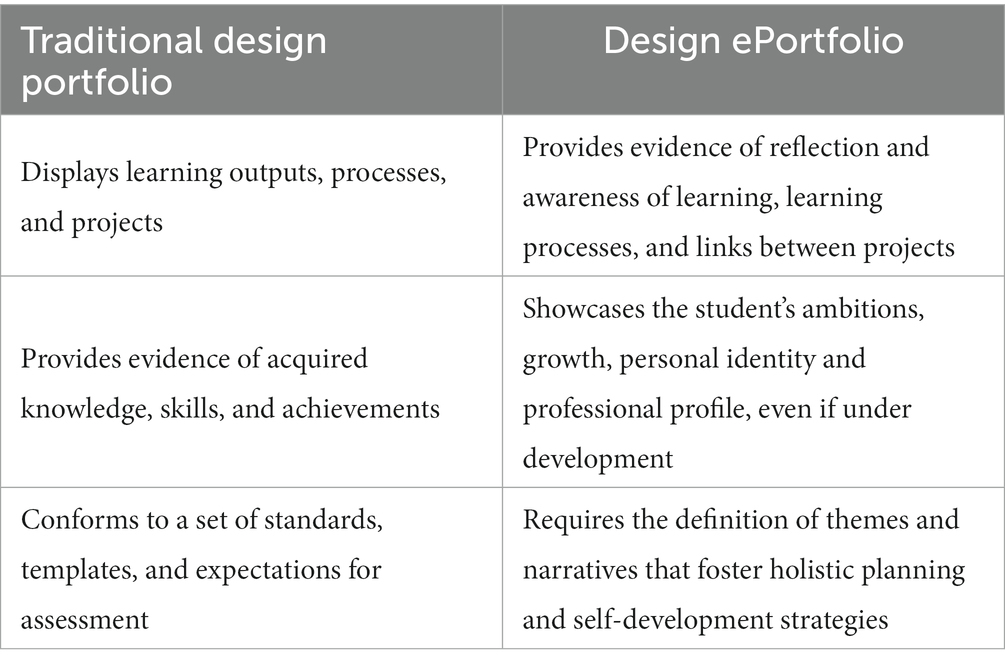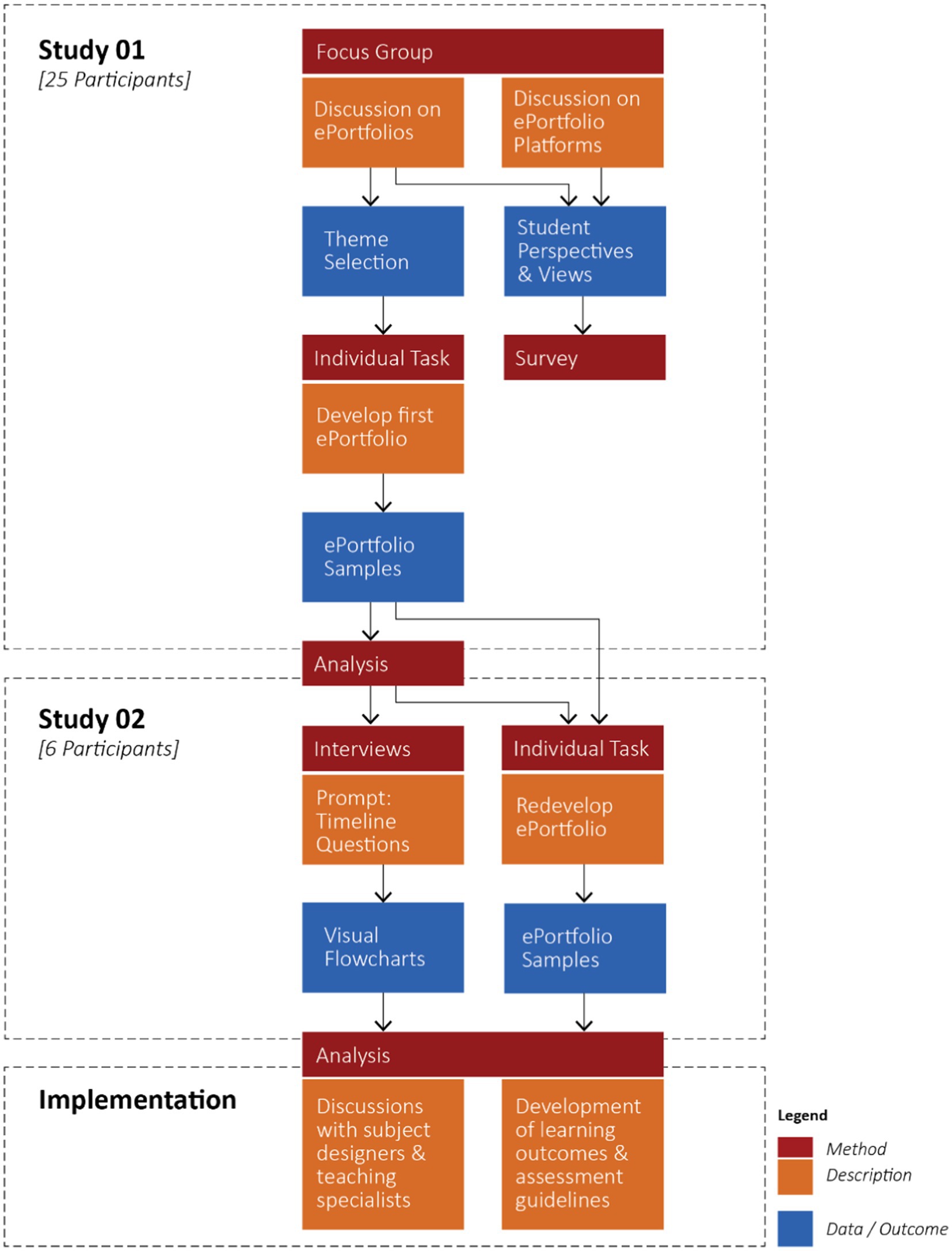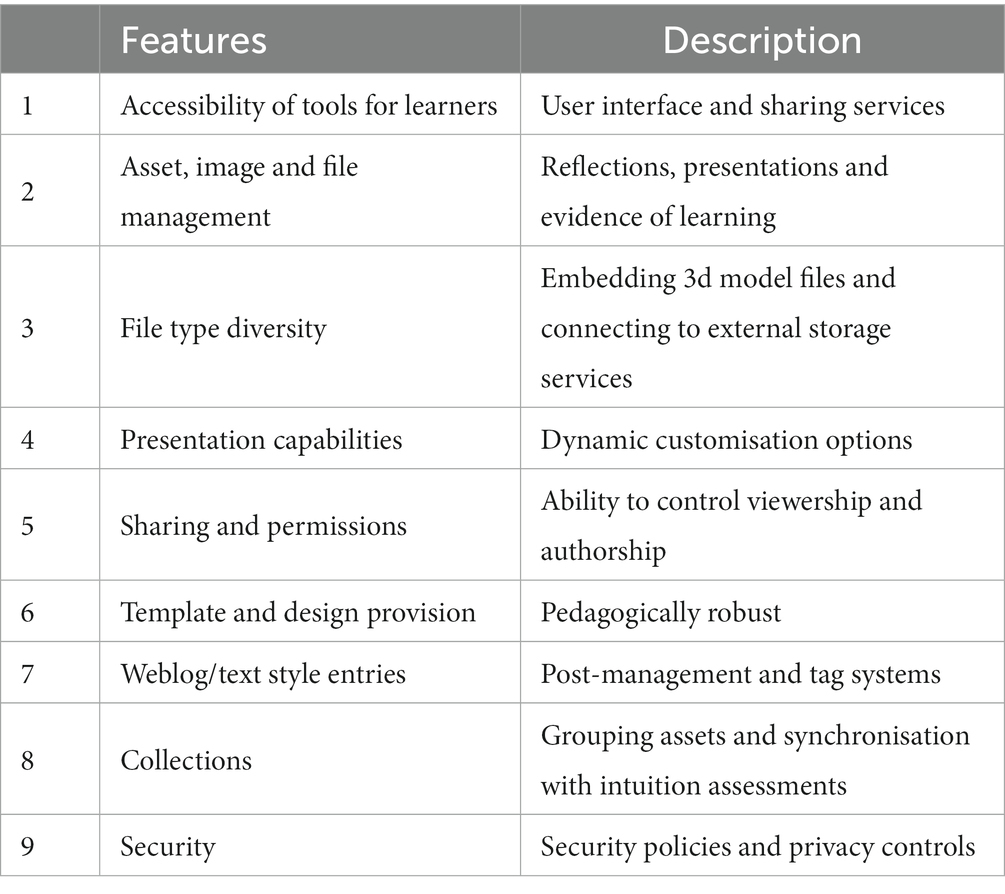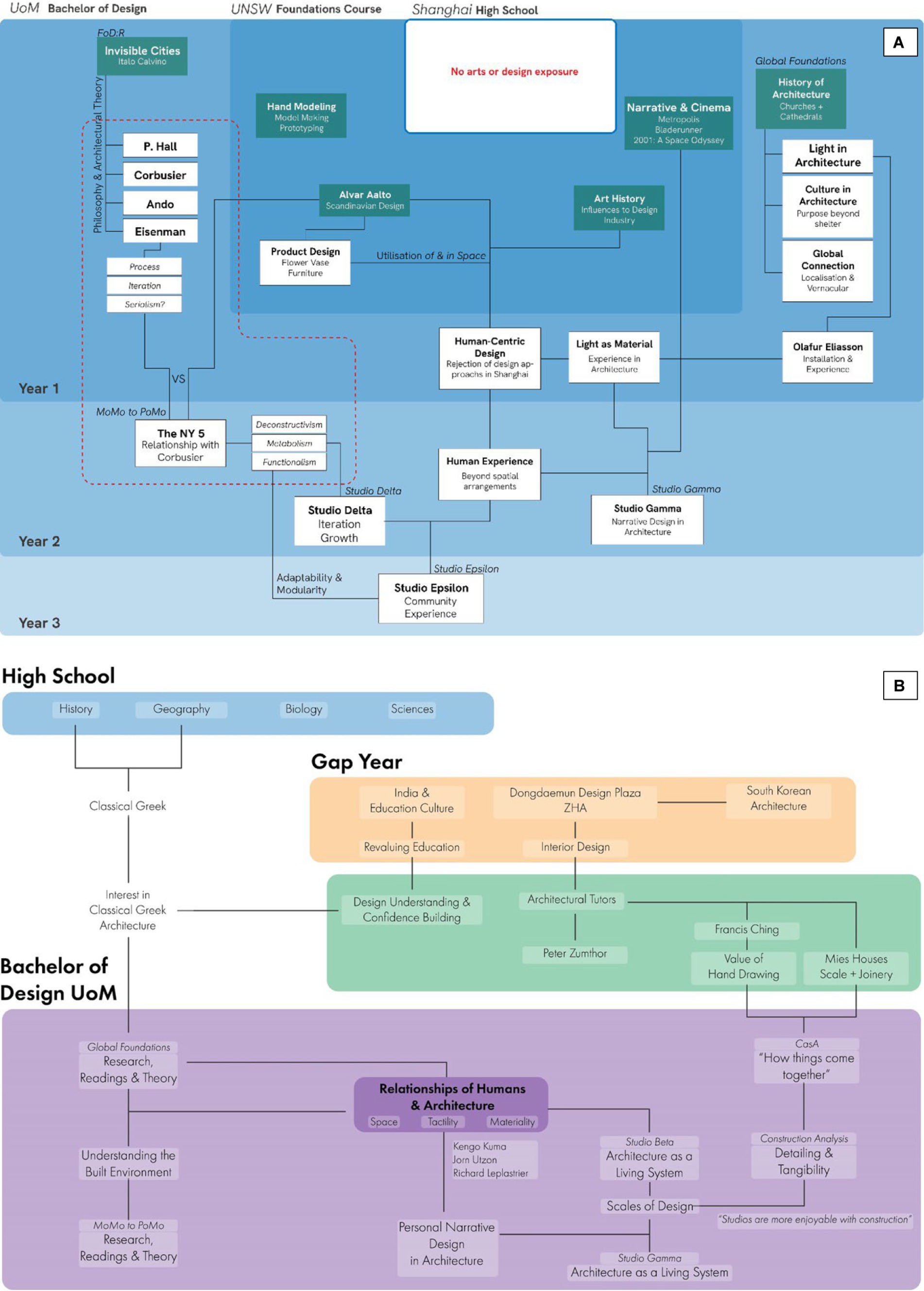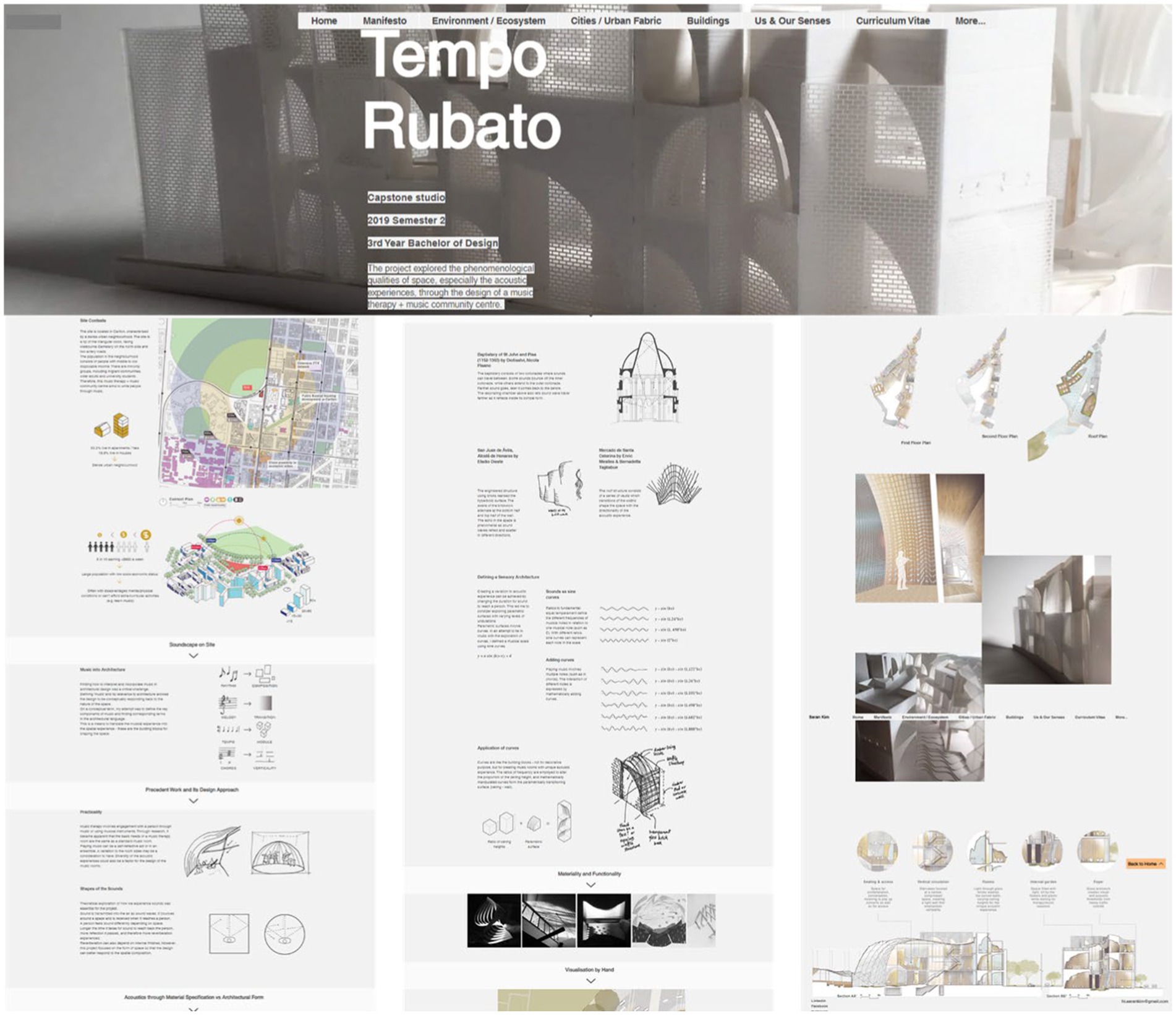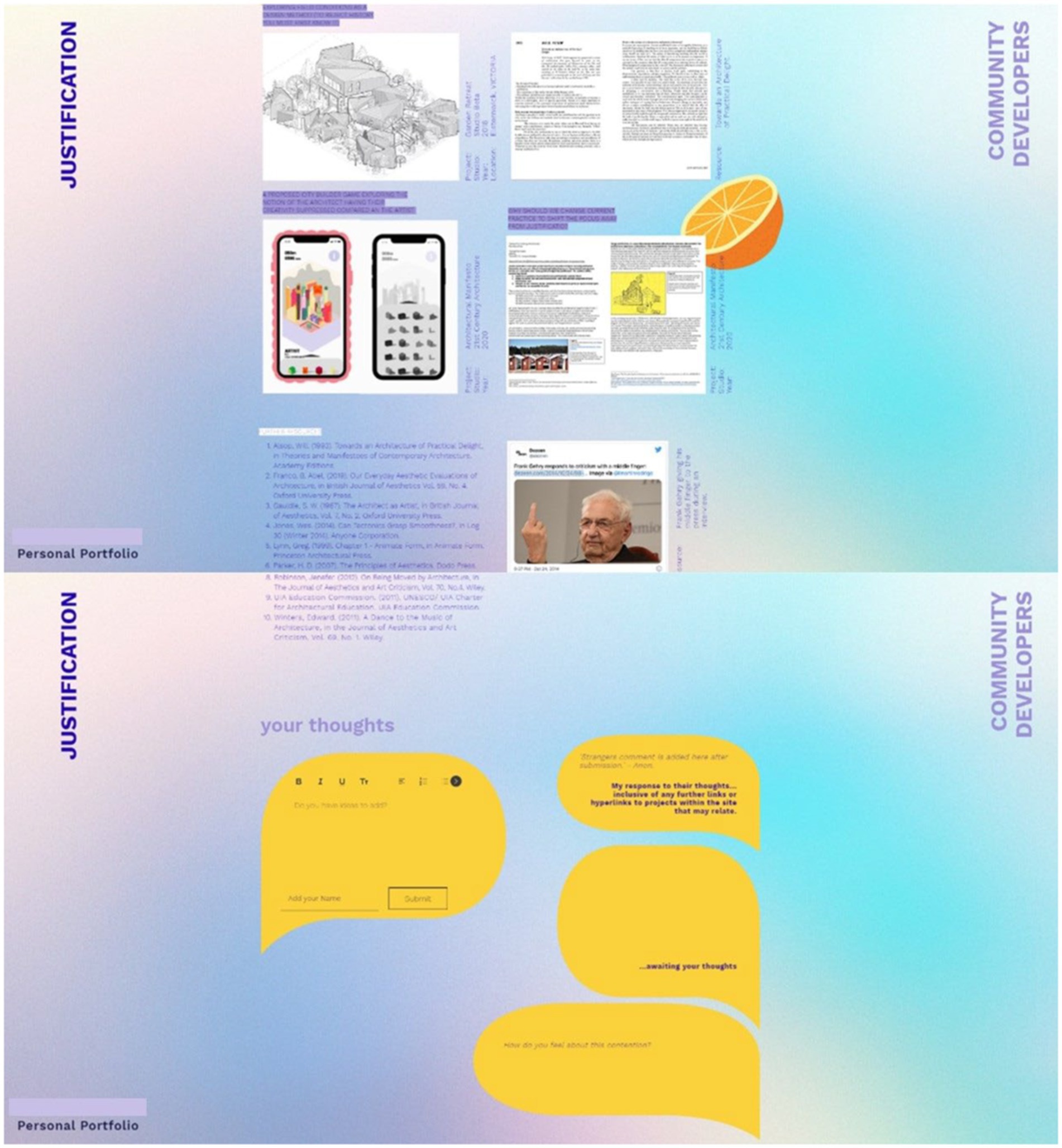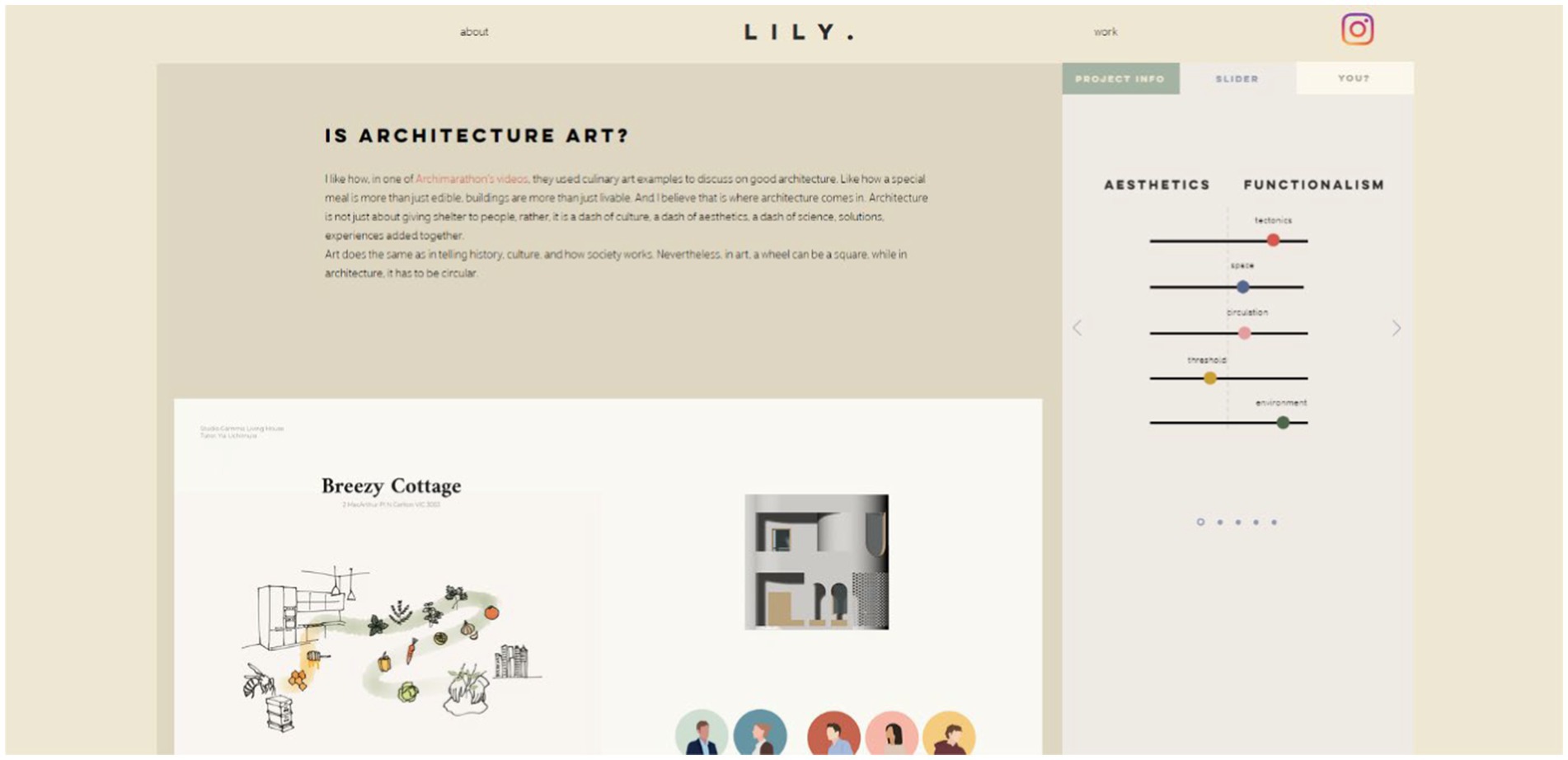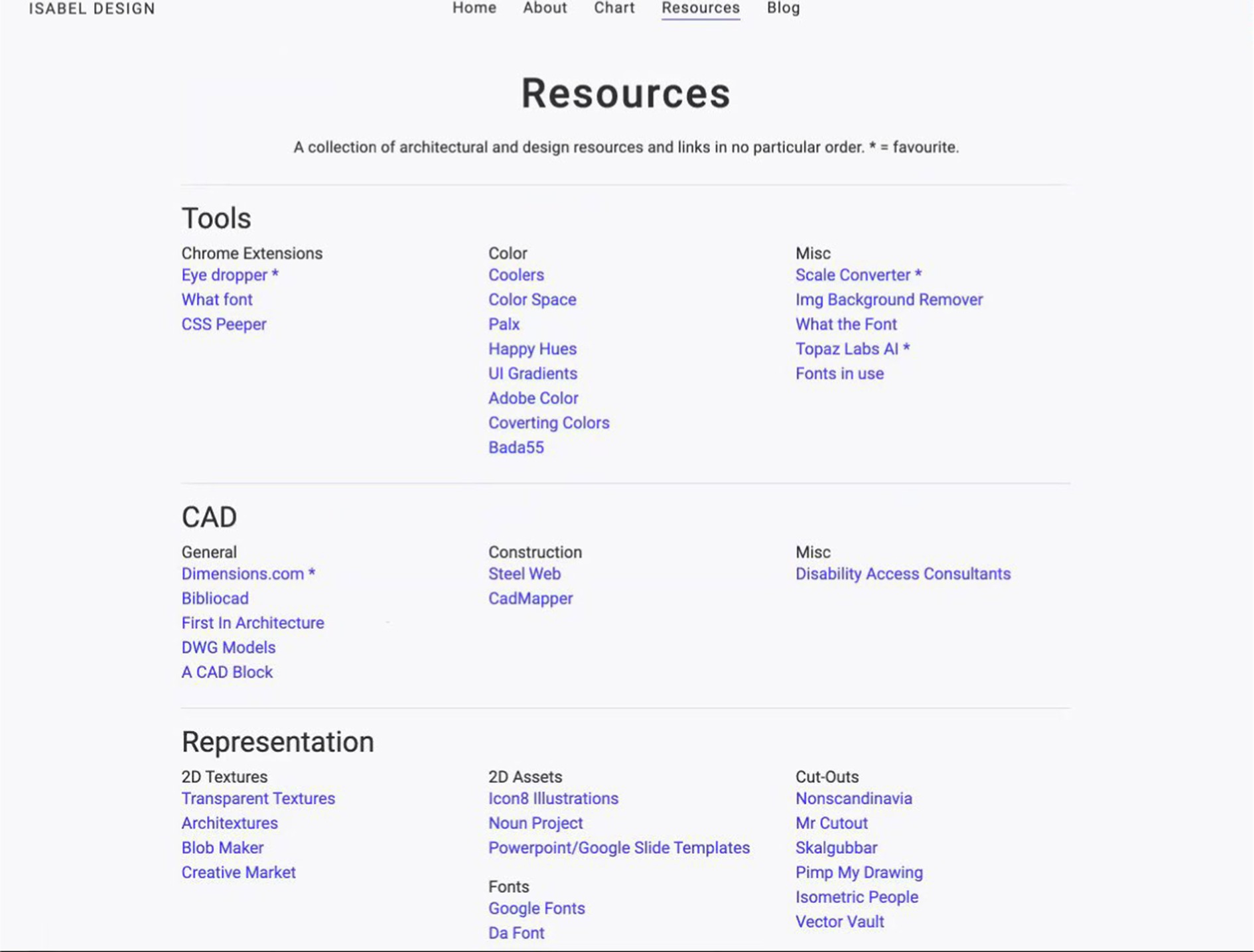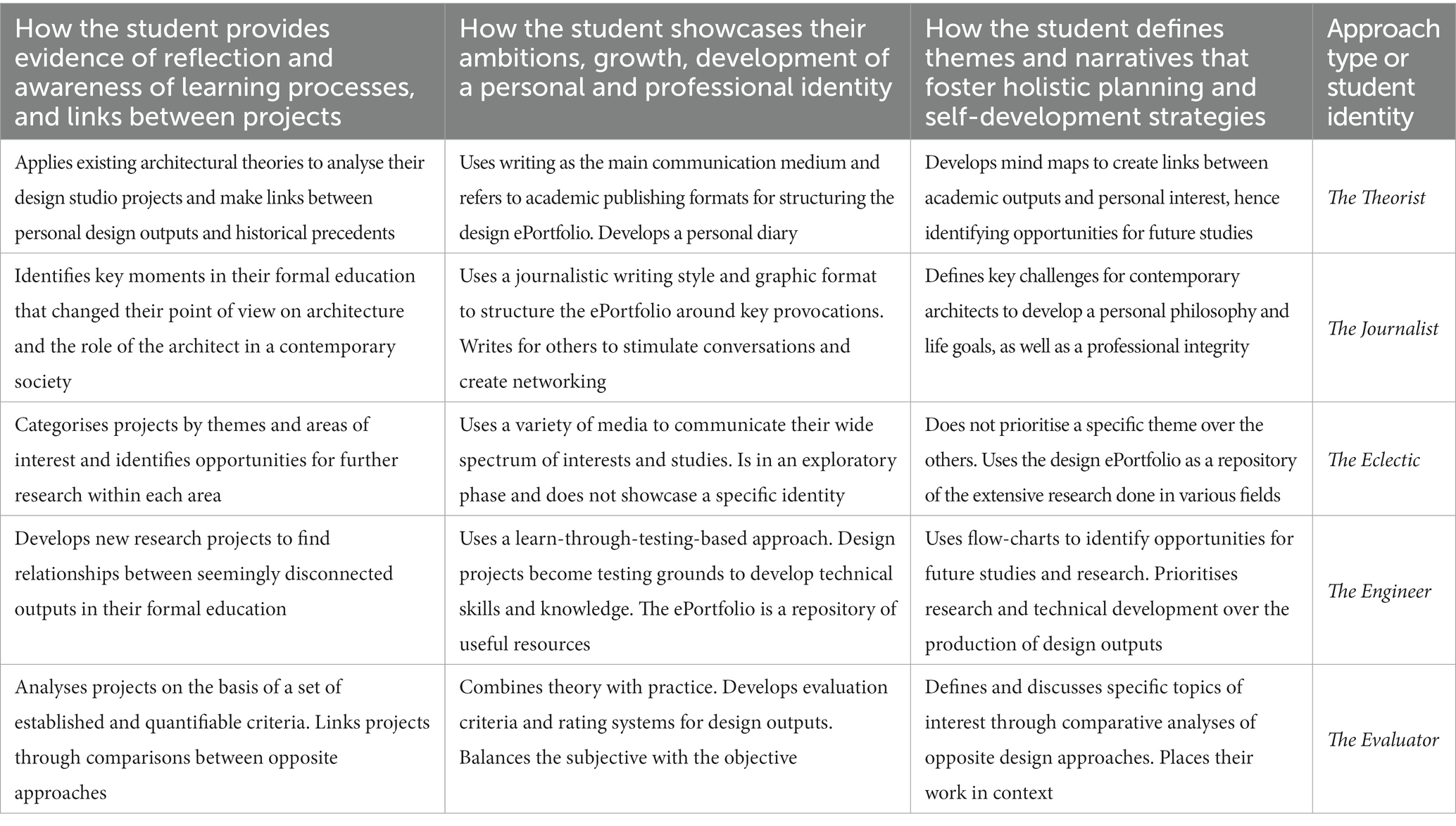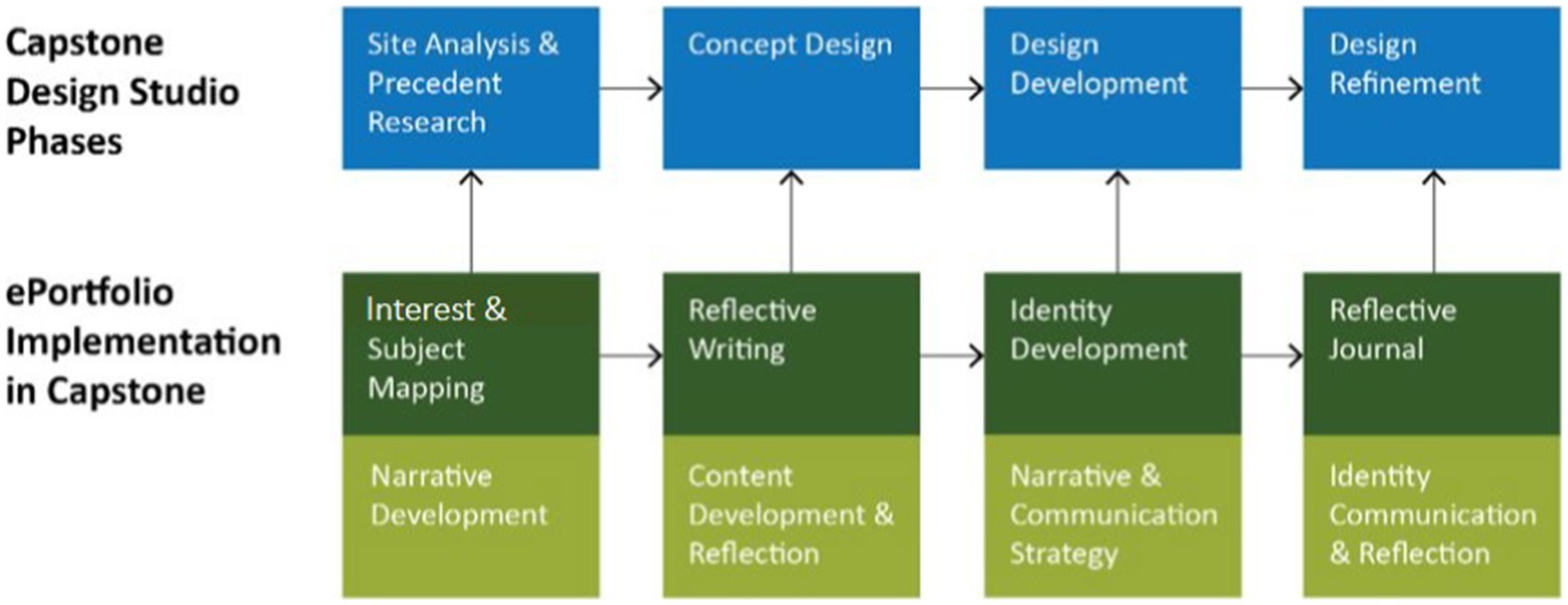- Faculty of Architecture, Building and Planning, The University of Melbourne, Melbourne, VIC, Australia
This paper presents the different steps of the journey that led to the development and implementation of a design ePortfolio as part of the “Architecture Major” of the “Bachelor of Design” (BDes) at The University of Melbourne, Australia. This design ePortfolio was developed over 2 years through interviews, focus groups with students, and the development of exercises and assignment guidelines. The implementation took place in different phases, starting with the introduction of four thematic exercises in the Capstone Architecture Design Studio of the BDes, and then, more broadly, at the curriculum level, with similar activities that prepared the students to already start developing a reflective journal from the first year of their studies. The objective of this research has been to explore the potential of integrating a design ePortfolio with traditional design portfolios on the curricular activities of an undergraduate architecture degree to prioritise the students’ reflections on their personal qualities, growth, career trajectory and goals, as well as on the relationship between curricular and extracurricular activities rather than those of a conventional design portfolio, which tend to be focused more on showcasing skills and competencies. The results of this two-year project illustrate the potential of such a teaching/learning tool to link the personal and professional interests and achievements of students holistically, therefore highlighting the relationship between curricular and extracurricular activities, as well as indirect connections between design studios and seminar-based subjects, that is, history and architectural technology subjects. So far, our design ePortfolio has been successfully used to encourage architecture students to reframe problems through a different lens and, as a key to creativity, to distinguish themselves from the homogeneity of students the university produces through its degree structure and modes of operation. The significance of this teaching and learning project lies in the identification of patterns in the curricular and extracurricular experiences of students that helps them define their identity, goals, and purpose. For this reason, this research has the potential to be linked to the University’s “Student Life” project, which is related to academic advice, personal growth, mentorship, and the well-being of students.
1. Introduction
This paper presents a research project that was conducted at the Faculty of Architecture, Building and Planning (ABP) of The University of Melbourne, Australia, which involved designing, testing and implementing a new design ePortfolio as part of the “Architecture Major” in the “Bachelor of Design” (BDes) course. The project aimed to reinforce the existing interactions and collaborations among subjects and develop a greater awareness of the “Melbourne Model” and its flexibility.
The Melbourne Model was introduced in The University of Melbourne in 2008 to replace the institution’s 96 undergraduate courses; it involves 6 undergraduate degrees and professional programmes, and is aimed at fostering the capacity of students to become independent and innovative thinkers and to adapt to a future that cannot be predicted. Introducing flexibility meant adopting new sets of skills and different tools to map the students’ growth and for these students to define their own study path.
While examining the entry requirements of various architecture master’s degrees, it emerged that traditional project-based portfolios needed to be renewed in favour of more flexible and reflective portfolios. Design portfolios are commonly used in architecture schools to assess prospective students on the knowledge and skills they had acquired during their previous studies, and they are often used in practice to shortlist architecture graduates for job positions. However, these design portfolios are usually effective in showcasing drawing and communication skills but rarely foster reflection on previous experiences, personal qualities, ambitions and potential career pathways. Moreover, a traditional portfolio is often a private document that is developed independently as an unsupervised activity that students perform outside their regular courses and curricular assignments. In such a scenario, ePortfolios have been considered as an opportunity to favour effective teaching/learning tools that could link the students’ personal and professional achievements holistically: ePortfolios seem to highlight the relationship between curricular and extracurricular activities, to structure broader connections between learning experiences and previous knowledge, and thus to connect design studios with seminar-based subjects.
The “ePortfolio” concept emerged during the transition between paper and digital portfolios, which progressively occurred over the last two to three decades in many design-based disciplines, such as architecture. During this period, many researchers noticed that the digital domain had much more to offer students and their supervisors than a mere format conversion. Reynolds and Patton (2014) stated that “the digital format allows eportfolios to be collaborative rather than individual. They develop students’ critical thinking, create opportunities for student reflection and integrative learning, and allow students to demonstrate learning through multiple modes—visual, oral, written, and video.” They also wrote that “eportfolios are digital representations of students’ work and accomplishments along with their reflections on learning. The eportfolio has the potential to enhance student learning through the process of collect, select, reflect, and share.” In the Field Guide to ePortfolio by Batson et al. (2017), ePortfolio is described as an interactive and online repository of students’ skills and experiences, which is accessible to teachers, peers and future employers, allowing new practices to enhance reflections on learning (Barrett, 2010; Batson, 2017). Unlike traditional portfolios, ePortfolios provide an online resource for students to record and reflect on their artefacts and learning. A digital portfolio differs from an ePortfolio in that it only functions as a repository. Conversely, the ePortfolio concept is not dependent on specific software packages or digital platforms because, as explained by Barrett (2010), it should be seen as the combination of a process (a series of collection, selection, curation and reflection activities) and a product (the result of such activities).
This paper, by challenging the existing design portfolio approaches, and embracing an ePortfolio-based learning strategy, provides a new method and set of tools to transition from conventional design portfolios to design ePortfolios. As an output of our research project, it answers the following three questions:
Q1. How can different ePortfolio platforms foster architectural students’ reflections on their learning, personal identity development and growth, ambitions, and communicate the process and results of such reflections to others?
Q2. What types and formats of ePortfolio can be developed and used to best scaffold the students’ learning, reflection, experimentation, and progress in core subjects within the undergraduate architecture major of the BDes?
Q3. How and when can ePortfolio be incorporated in assessment tasks of the core subjects within the architecture major of the BDes?
The paper is divided into the following sections:
ePortfolio Background, which describes the background, challenges, and opportunities of ePortfolio and some of its distinct features, in particular in comparison with the format of traditional design portfolios: the latter aspect was the main challenge of this study. The follow-up task was finding an identity for the ePortfolio model in a discipline and a degree course in which the use of portfolios has always been standard practice for both architects and architectural students.
Methodology, which illustrates the research design, methods, and project timeline, and a detailed breakdown of the study phases. In the first part of the research, we aimed to explore the students’ understanding of the purpose and impact of ePortfolios in their education and the factors that could act as facilitators or barriers to using such approaches. In the second part, we guided the students towards implementing their first ePortfolios. Throughout the project, we facilitated focus groups, conducted interviews, and supervised exercises to design ePortfolio drafts that could then be used to implement ePortfolio within the existing core subjects of the BDes.
Results, which illustrates some of the design ePortfolio outcomes; it compares different commercial ePortfolio platforms and discusses why it was essential for architecture students to develop their medium and include presentation and communication strategies as part of their tasks.
ePortfolio implementation, which describes how our design ePortfolio assignment was developed and implemented in the Capstone Architecture Design Studio of the BDes. This implementation can be considered the first step towards a wider introduction of the design ePortfolio into the degree structure to encourage reflective thinking in the early stages of the student’s learning journey, already in the first year.
Conclusions, which summarise why our design ePortfolio implementation proved to be a valuable resource for the BDes architecture students.
It is worth noting that, due to the restrictions imposed by the COVID-19 pandemic and considering the rapid shift to remote teaching and learning, this project was developed entirely online, thus obliging the staff and students to embrace the opportunity of developing design ePortfolios in a fully digital manner. Focus groups and interview sessions were conducted online using Zoom for video conferencing and the Miro visual collaboration platform, which allowed a close mentoring relationship to be set up between the researchers and participants but also created a weaker peer-to-peer experience. This issue was not perceived as a major hurdle, given the inherent mentor/student relationship that is conducive to the guided, self-reflection nature of the task. The design ePortfolios were developed fully online as websites and are presented as snapshots of the original products.
2. ePortfolio background
The preparation of an early pilot ePortfolio was begun in 2005 by the Centre for Integrative Learning CETL, and from 2009 onwards by the Centre for International ePortfolio Development (CIePD) through funded project work of the Joint Information Systems Committee (JISC).1 The JISC funded the e-Portfolio Implementation (ePI) study, from August 2010 to May 2011, to (1) identify a range of examples of wide-scale ePortfolio implementations that would inform practice, (2) gather a range of case studies to support the articulation of implementation models, and (3) develop an appropriate means of disseminating the outcomes that would enable the potential users to understand the implementation issues and identify the aspects that were most relevant to their specific contexts. Eighteen participants contributed to the JISC study: eleven were from the UK, four from Australia, and three from New Zealand.
In the middle of 2007, the Australian Learning and Teaching Council (ALTC) commissioned an intensive research project to a consortium of four universities (the Queensland University of Technology, which was the lead institution, The University of Melbourne, the University of New England, and the University of Wollongong). The project examined the use of ePortfolios by university students in Australia. The Australian ePortfolio Project (AeP) was the first attempt to explore the breadth and depth of ePortfolio practices in the higher education sector in Australia. The AeP lasted over 12 months, with the final report released in October 2008. Hallam and Creagh (2010, pp. 185–186), in their review of the Australian ePortfolio Project, pointed out, among the outcomes of the project, the high potential of ePortfolios to “assist students to become reflective learners, conscious of their personal and professional strengths and weaknesses (…). There was a strong understanding of the need for interoperability across the different areas of education and employment, which resonated with the current government policy focus on integration between vocational and higher education and the articulation of employability skills.” They also argued that ePortfolio approaches in Australia were inconsistent across different institutions and that early adopters generally utilised coursework-centric programmes instead of faculty- or university-centric ones.
It has long been claimed that ePortfolios support competency-based medical education globally. Since 2010, four UK medical schools have collaborated with a major National Health Service (NHS) portfolio provider to create an electronic portfolio for medical students, the Undergraduate Medical ePortfolio (UMeP), which was adapted from the ePortfolio used by most Foundation Programme doctors in the United Kingdom (Belcher et al., 2014). EPortfolios have long been trialled in the Australian medical education context to support reflective practices and formative assessments. EPortfolios were introduced into the Sydney Medical Programme (SMP), a four-year graduate degree course at the University of Sydney, in 2015, to improve the assessment and feedback provided to students (Bleasel et al., 2016). More generally, ePortfolios are utilised in different ways across institutions and faculties. The Pennsylvania State University, in the United States, provides specific step-by-step guidance to encourage students to create a storyboard of their life as a part of their ePortfolio development.2 In 2007, the City University of Hong Kong started a pilot study to investigate the potential integration of ePortfolios across courses, including non-curricular learning experiences (Cheung et al., 2009).
In 2017, the Association for Authentic, Experiential and Evidence-Based Learning (AAEEBL) assembled the Field Guide to Eportfolio. They combined entries on the most critical dimensions of the ePortfolio concept in the United States with case studies from other countries (Batson et al., 2017). The publication of their field guide signed a milestone in the evolution and adaptation of teaching and learning activities to digital technologies.
2.1. From traditional design portfolio to design ePortfolio
Although the existing body of knowledge tends to highlight the pedagogical benefits and applications of ePortfolios, there still is a lack of specificity in their implementation to address the specific requirements of each faculty. When this research project was started, no general framework existed to enable an architecture faculty to utilise ePortfolios. Some of the ePortfolio teaching and learning studies that were available when this research project was first started and some selected case studies are listed hereafter.
The Pennsylvania State University has introduced ePortfolios into its curriculum. They have acknowledged that ePortfolios allow students to tailor their learning experiences to meet their needs and clarify their aspirations, take ownership of their learning, and integrate the learning artefacts produced in multiple forms (audio, video, image, and text).3 Their approach is pioneering because of their integration with Canvas and the use of free platforms such as Google Sites, WordPress, and Edublogs, all of which allow ePortfolios to be created easily and scaffolded by many online tutorials. They also provide links and resources to help reflective development, from tips on storyboarding and multimedia editing to colour palette generators and blogging. Their community and gallery spaces are accessible to the public and institutions, allowing for transparent collaboration and viewership. The approach taken by the Pennsylvania State University encourages the development of an academic portfolio that prioritises progressive learning but also provides context to intended learning outcomes, the social aspects of education and digital competencies. Their storytelling resources and workshops include “three universal principles of storytelling: audience connection, showing vs. telling, and story structure”.4 The storytelling aspect was beneficial for our team to frame the first exercise of the focus group (see: Methodology).
Roco and Barberà (2020) reported the necessity of implementing ePortfolios as a teaching and learning strategy in Architecture Design Studios because that is the context that requires the highest integration of a student’s previous knowledge. Their study is based on the implementation of ePortfolios in the Architecture Design Studios of the University of Catalonia, Spain, during six academic semesters, between 2012 and 2014. The authors revealed that although the implementation of an ePortfolio had been successful in the courses, the responses from the students indicated that its utility as a reflective tool had not been fully realised. A survey conducted at the end of the study showed that 12% of the students responded that they thought the ePortfolio was for reflective purposes, and 50% responded it was for the communication of completed work. These data can be interpreted in many ways, one of which is that the interviewed cohort had misinterpreted the task, and these considerations served as a point of reference in our study to frame the communication with the student participants in the focus groups before the ePortfolio strategy was adopted in the Capstone Architecture Design Studio of the BDes.
The vast gallery of ePortfolio samples from Griffith University, Australia, allowed us to explore, in the early stages of this research, the multiple ways ePortfolios could be used to engage students while also providing graduates with a better sense of purpose when enrolled at the university, and a good understanding of their abilities as they move forward in their careers.5 Moreover, using PebblePad as a primary platform allowed us to obtain an initial sense of the potential and limitations of this tool. On the other hand, the University of Auburn, in the United States, displays various ePortfolios that show students’ learning to audiences outside academia, but they do not limit the used platform.6 These experiences fostered conversations with students during the first two focus group meetings, which were held to evaluate what platform was most suitable for the scope of the exercise.
2.2. Challenges and opportunities of design ePortfolios
Based on an initial analysis of the uses of ePortfolios, and since design journals and portfolios are commonly used in architecture schools, we deemed it essential to draw a clear distinction between the features of traditional design portfolios and our idea of design ePortfolio.
Despite the many similarities between paper portfolios and digital portfolios, the transition of paper to digital supports is primarily a change of medium: it does not automatically imply a change in content or lead to a transformation of the portfolio scope. For this reason, we refer to both paper and digital design portfolios as “traditional design portfolios.” Reflection on learning and awareness of the learning processes are usually missing in such traditional design portfolios, regardless of the medium with which such portfolios are prepared and presented to others. The maturation of a personal identity and a professional profile are also critical aspects of a student’s growth path but are rarely visible through a simple collection of design outputs.
Table 1 summarises the key goals of the design ePortfolio in comparison with the traditional purposes of a design portfolio. While preparing this table, it soon became apparent that a design ePortfolio can easily integrate the features of traditional design portfolios with the idea of helping students develop a more metacognitive approach to learning – as defined by Biggs and Tang (2011). As highlighted by Veneruso et al. (2017, p. 32), “students need to learn how to identify, explore, and explain connections that may unify the many factors of their academic, professional, and personal lives.” From a pedagogical perspective, the development of design portfolios does not necessarily highlight the breadth of exploration of interests of students across different subjects or skills gained through extracurricular activities and their impact on design outputs. Although Schön’s model of design thinking as reflection-in-action dates back to 1983, it is apparent that traditional design portfolios usually contain only a few of those reflective components and do not necessarily comprise an interdisciplinary process, inclusive of the learners’ strategies for learning, their previous knowledge, or even their diverse interests and motives (Schön, 1991).
We developed the idea that the design portfolios could evolve and expand towards a process that could incorporate an extended and broader journey to thus become a design ePortfolio just after the first stages of the research. The definition developed by Barker (2006, p. 8) of an ePortfolio as a “process and product” sparked the idea that an ePortfolio could display and communicate projects and assets in conjunction with documentation of the learning process and personal reflections while showcasing anchor concepts, their mutual relationship and how they have been translated into new knowledge. This kind of portfolio would differ from a traditional design portfolio, where the projects include representative artefacts of the process and outcomes. A design ePortfolio guides students beyond learning activities to appreciate the learning journey as a creative and interdisciplinary process. Because of its web-based nature, the design ePortfolio offers an opportunity for peer learning, collaboration, and interaction, through shared platforms over time. Because of its very nature, even the most advanced design portfolio is goal-related and time-constrained; in most cases, given the complexity of the design process, interdisciplinarity is marginal and is not necessarily focused on the student’s passions, past experiences, or future goals.
Because of the complexity of the information included in ePortfolios, this approach triggered a reflection on the different types of assessment, which could become summative and formative, qualitative and quantitative, according to the diverse uses of the ePortfolio. A further crucial theme of our project was to identify methods and means to scaffold the students’ learning journey towards critical thinking and creativity. As Sinek (2011) mentioned, many people focus on coming up with ideas before figuring out how to execute them, while he suggested being put in the middle of chaos and finding patterns; once a map of patterns has been placed in context and developed, there are high chances to find a possible solution to the task. Our project gathered much from Sinek’s belief that creativity can be taught through mapping patterns to enhance a process that begins before students have an idea instead of being stuck until that moment. This assumption triggered further discussions on the learning objectives and outcomes of design ePortfolios, as well as on the taxonomies of learning, and on the potential assessment strategies, up to the alignment of an ePortfolio with the students’ curricular activities.
3. Methodology
As ePortfolios had already been applied in faculties other than architecture, such as medicine and social sciences, the first part of our study focused on identifying the differences and similarities of scope between architecture and other disciplines. A further distinction was made to establish the ePortfolio model’s reflective nature, which, as mentioned in Section 2.2, was not a digital version of the traditional design portfolio but a tool for authentic learning based on personal trajectory, career development and identity.
This research was based on ‘mixed methods’ requiring linkage and integration in data collection, quantitative and qualitative data analysis and interpretation of the evidence, as explained by Creswell and Plano Clark (2007). The Mixed Methods Research (MMR) allowed us to review, adjust and expand our research questions throughout the project, develop new tasks and tools, such as the timeline and mapping exercises, explained later on in Section 4.1, interpret the students’ works, including their own perspective, and inform a cultural paradigm shift in the uptake of design ePortfolios within our faculty.
3.1. Description of the research phases
We divided our research project into two main and sequential studies: the first intended to collect and analyse quantitative data from a small group of student participants; the second focused on collecting qualitative data from an even smaller, selected sample of students.
Study 1 consisted of two focus groups with 25 students and aimed to test and evaluate various ePortfolio platforms through an individual thematic exercise and a short survey. The exercise was also designed to prompt students to develop a range of design ePortfolio drafts for further analysis and refinement during the second study. Through this exercise and related discussions in the focus groups, we tested the ability of the students to have agency over their learning. The short survey responses informed the design of the second study, particularly regarding the platforms and tools used.
This preliminary study aimed to discover what the “invisible learning” processes, as defined by Bass and Eynon (2009), were based on for the BDes student cohort and how to make these learning processes visible and more meaningful using digital tools. This study also encouraged reflection on students’ learning processes in design studios and seminar-based subjects while considering their passions, ambitions, and personal events. The first focus group was based on a discussion about the research questions and goals and was followed by Q&A with the participating students on possible ways of structuring a design ePortfolio; the main challenge in this first meeting was to clarify differences from and analogies with a traditional design portfolio. At the end of the session, the students were briefed on expanding a curated collection of artefacts through the lens of their reflections. Already at this stage, the students stated that they would prefer to make their own container of artefacts without the constraints of a pre-built platform. This result was not surprising, as architecture students are generally inclined to express themselves through diagrams and graphical exercises. The second focus group was based on the students’ feedback on the process, and a review of their findings and collections of artefacts. After the second focus group, the students were asked to connect their reflections to a broader and multidisciplinary scenario, this time considering the entire formative process.
Study 2 began with selecting 6 ePortfolio drafts produced by the students during the previous study, hence shortlisting 6 participants—the authors of the selected ePortfolio drafts—according to criteria that ensured a diversity of interests, ambitions and approaches to the initial exercise. This second part of the research was based on individual interviews and guided tasks to further develop the students’ design ePortfolios. At the end of the study, we surveyed the 6 student participants to get their view on implementing the design ePortfolio exercise within our curriculum. Through the semi-structured interviews with the students, we drew maps of each student’s visible and invisible learning processes. As most of the students showed a propensity towards creating their custom-made visual medium to illustrate their learning journey, this stage of the research was also based on ways of implementing the students’ maps of critical reflections through a cloud-based web development service (Wix) that allowed the students to indicate the outcomes of their reflections, activities, and passions, through the development of their design ePortfolios.
It is worth underlining that, for these two studies, we recruited student participants within the Faculty of ABP. We targeted specific student groups and cohorts to collect a broad range of views from a diverse and inclusive set of participants of both national and international origins. We also mixed recent graduates with current 2nd- and 3rd-year students to investigate where the ePortfolio implementation would be more useful within our curriculum. The shortlist made for the second study specifically favoured academically high-achieving and well-engaged students with faculty activities and events, as we anticipated a significant time investment for these participants in the second study, which included individual interviews and the development of a refined design ePortfolio for each student.
The research project concluded with the implementation of our design ePortfolio model in the Capstone Architecture Design Studio of the BDes in 2020, which provided further feedback to adjust the task to the scope of the subject. This first implementation was based on the key findings of the two studies and helped us understand to what extent the design ePortfolio model could be generalised for a broader implementation in the Architecture Major of the BDes. It suggested a new series of curriculum development strategies that led to this implementation of ePortfolio being expanded in year 1 of the BDes. Following up on Kirschner and Hendrick’s notion (2020) that the growth of reflective abilities is founded on prior knowledge, we assumed that a design ePortfolio had to be structured in such a way that would guide students on how to use what they had been learning progressively. This assumption was fostered by The University of Melbourne’s implementation strategy, which encourages students to link learning across interdisciplinary subjects in a holistic approach to learning via ePortfolios. This final phase also provided us with a much larger dataset of design ePortfolio samples and resulted in the development of four tasks and guidelines for the development of design ePortfolio within Architecture Design Studios.
The diagram in Figure 1 illustrates our methodology and the project timeline, from the initial brainstorming group discussion and focus groups to the final implementation within the Capstone Architecture Design Studio of the BDes.
4. Communication platforms and strategies
Although Higher Education institutions and professional organisations worldwide have widely recognised the need for implementing ePortfolios, specific platforms and development strategies remain relatively unanalysed. In 2020, The University of Melbourne assessed different platforms for the implementation of ePortfolio (PebblePad, Portfolium, My Knowledge Map, and Mahara). One year later, PebblePad was adopted by various Australian universities (The University of Melbourne, Deakin University, Monash University, the Royal Melbourne Institute of Technology, La Trobe University, the University of Tasmania, James Cook University, and many others). It is worth mentioning that the adoption of the Mahara open-source platform for ePortfolios started in 2012 at the University of Nottingham (Joyes and Smallwood, 2011). PebblePad, a leading platform for the generation of ePortfolios, started in the UK in 2004, was launched in Australia in 2009, and then in North America in 2015.
Prior to the commencement of the focus groups, we tested seven relevant ePortfolio platforms currently used within higher education institutions: PebblePad, Portfolium, My Knowledge Map, Mahara, Canvas, Google Sites, and Wix. Different faculties present distinct requirements for their assessment tasks; hence, a checklist was developed to compare the available ePortfolio platforms. The shortlisted platforms were based on the criteria outlined in Table 2. These were, in turn, based on a standard set of tools and capabilities established by ePortfolio platforms and provided by the developers of PebblePad—a benchmark for a platform with the most features. Of the seven platforms that we evaluated, Portfolium, PebblePad, Mahara, Google Sites and Wix offered a diverse range of templates with varying levels of design flexibility.
In our first study, student participants were allowed to use a platform of their choice. 19 students decided to test Wix, and only one student used Portfolium, mainly because of the rigidity of more structured platforms, which offer a low degree of customisation, thus confirming the students’ propensity to develop custom-made outputs to communicate their ideas visually, as encouraged by the degree. By providing less tailored features, the resulting prototypes developed more nuanced strategies at a graphical and tangible level.
5. ePortfolio types and formats
Study 1 and Study 2 and the individual supervision sessions with the students led us to formalise exercises which supported the development of design ePortfolios in architectural education. These exercises are presented below in conceptual order, which was decided according to a critical review we conducted at the end of the research. The roles of graphic design, communication and the curation of ePortfolios were analysed at each stage of the process and were considered a vehicle to demonstrate achievement and as an integral part of the learning experience.
5.1. Timeline and mapping exercises
In Study 1, one of the participants proposed including a timeline diagram in her prototype to graphically illustrate the relationship between her academic development and extracurricular activities, namely her involvement with clubs and social groups throughout her degree studies. Academic staff, advisors and mentors who were key motivators or who had a significant influence on the student’s education in design were included in the map and indicated in a specific layer (Figure 2A). The vertical axis represented the chronology of the student’s academic coursework, and the horizontal axis, including highlighted bubbles and notes, represented the diverse dimensions of the student learning processes, which included cultural, social, and/or environmental factors, as well as any other personal, extracurricular, or professional experiences. The student timeline was then used as a work sample because it helped other students to build their own timelines quickly.
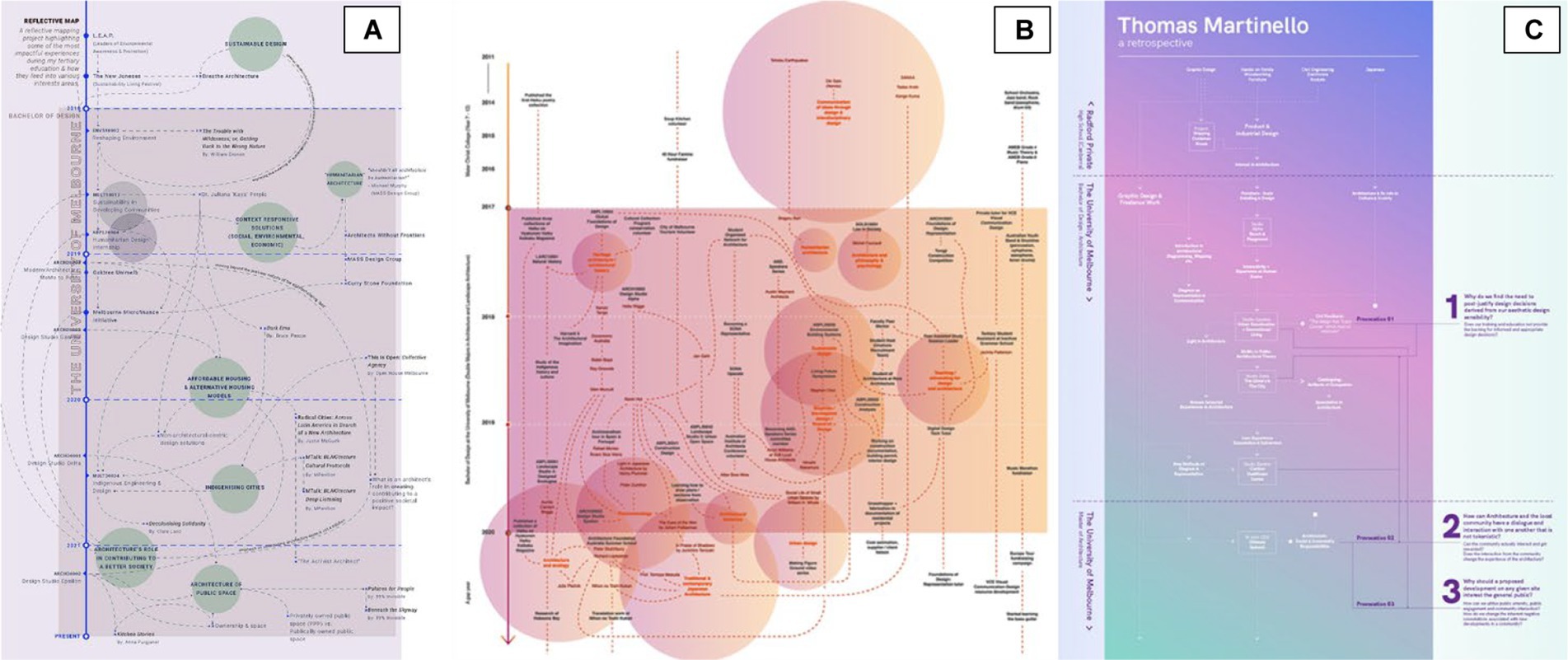
Figure 2. Three different timelines produced by the student participants. (A) Student A, (B) Student B, (C) Student C (reproduced by permission).
At the time of the focus groups, Student B was working in an architectural office. Given her multi-layered interests and activities within and outside the field of architecture, her timeline was fundamental to ground her reflections and clarify the goals she wanted to achieve with her ePortfolio. After completing her timeline, Student B explained that she had seen the benefit of this task as both a reflective method and a graphically communicative tool to explore her own learning. Student B (Figure 2B) utilised a bubble-style diagram approach to group common influences and themes together. Rather than focusing on the chronology of her coursework, she used the timeline to track the development of her interests in and around design and architecture. Despite the reduced focus on chronology, her timeline led to clear communication of the relative levels of interest and influence on other aspects of her architectural work.
In order to expand the generative process of the timeline, we asked Student C to produce a timeline in a guided interview. In his initial ePortfolio prototype, Student C had identified several ‘provocations’ in the form of questions he had raised following the conclusion of his design studio projects as a result of criticism from tutors and guest panellists throughout his architectural education. Through his timeline (Figure 2C), Student C was able to easily communicate the links between his provocations and his design studio projects. More importantly, the timeline led to the identification of additional links, such as his work as a freelance graphic designer and his interest in diagrammatic representation and communication. After the interview, he reflected on the implications of each provocation and their relationships and impact on his design projects, which subsequently helped him clarify his stance on each.
The effectiveness of the timeline diagram in fostering associative thinking at multiple levels was tested by the other participating students, each of whom was interviewed for 30–45 min and encouraged to reflect on their interests and extracurricular activities prior to and during their enrolment in the degree course. Although the previous conversations had been relatively informal, the interviews were structured on the development of consistent prompts from the interviewers, e.g., phases of personal development, such as early life, secondary education, pre-tertiary education, and tertiary education. The prompts included potential influences on the student’s journey and included, but were not limited to, cultural or social background, hobbies and interests, extracurricular activities, and professional work.
Some of the prompts included:
• Indication of the high school the student had been enrolled in and the subjects they had studied.
•Indication of any part-time job and its influences on their university career.
•Indication of architects or artists who had influenced their design approach.
These prompt questions primarily aimed to identify critical influences that may have originated from extracurricular activities and social, cultural, or professional factors. The Miro online interactive whiteboard platform was used to explore and develop the timeline collaboratively and in real-time with each student. This also provided a graphical interface that was used to facilitate brainstorming. The colours on the Miro board template were examples of categorisations; however, the students and interviewers used the specific colours flexibly.
The prompt questions made the interviews more cohesive, holistic, and exhaustive in scope but also allowed sufficient flexibility to maintain a relaxed and conversational demeanour. This helped ensure the students were comfortable sharing information throughout the process. The students and researchers contributed to the online board by elaborating on milestones and critical events in the timeline. For example, a student reflected on their upbringing in Shanghai and how moving to Melbourne to study allowed them to explore and discuss politics and social issues more openly (Figure 3A). They addressed the breadth of the material they read about art and architectural theory, which became a formative component of their education. The Miro boards were developed based on templates developed. More information is available in the Supplementary material (Appendix A).
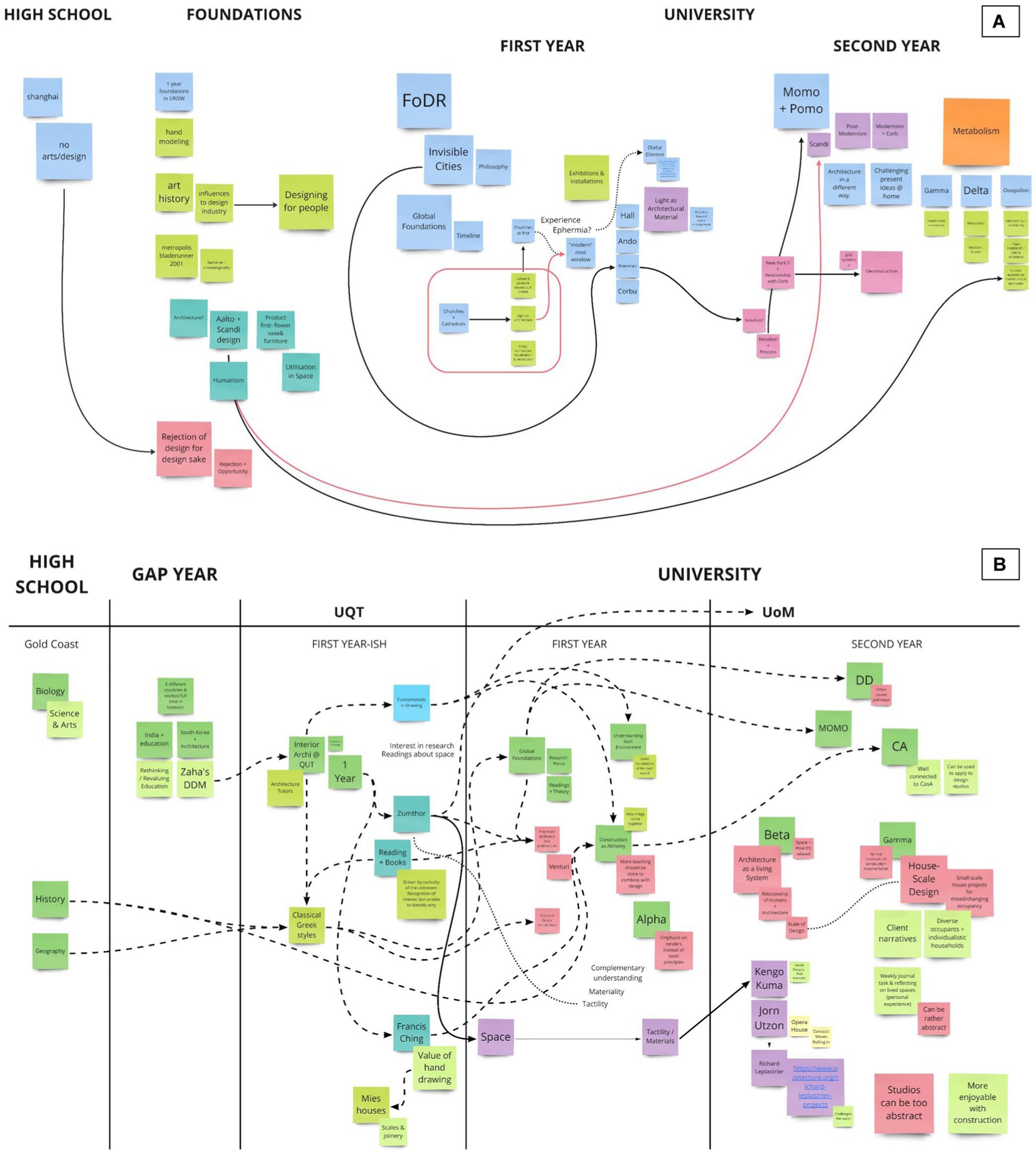
Figure 3. Miro board diagrams developed while interviewing students. (A) An international student who moved from Shanghai to Melbourne, (B) a student who travelled extensively during their studies.
In another student’s timeline draft, it was noticed how the chronology influenced the report on their learning journey (Figure 3B). They were also able to connect their cultural influences from travelling in India and South Korea to studying interior architecture and their interest in drawing to their enrolment in architectural education.
Both approaches were successful, and the fundamental insight is that how a timeline is developed and described allows the invisible learning processes to be visible in very different ways and to constitute the foundations for building an ePortfolio. We further developed both timeline drafts into sample diagrams to visualise standard modes that could be used to represent the learning journey and the reflective process graphically.
The formalised timeline of the first student, Student D, was developed to represent her outwardly expanding knowledge with links between influences located in the different positions around the diagram. The chronology was expressed through the expanding rectangles and at a distance from a core area of interest (Figure 4A).
The formalised diagram of Student E grouped influences from specific sources, thus making it easy to trace the lineage of specific impacts on her academic journey (Figure 4B). Student D and Student E found these diagrams highly beneficial to see their design journey communicated visually as they continued to develop and reflect on these connections. This feedback was consistent with the opinions shared by Student A, Student C and Student B on the relevance of the timeline exercise, where the graphical decisions were vital for both reflection and communication purposes.
This process confirmed the necessity of using the timeline exercise as a two-step process: (1) a brainstorming session to identify the key moments in the student’s learning journey, and (2) curation of the individual’s journey to leverage the students’ abilities to utilise their visual skills to communicate their individuality.
This timeline exercise proved essential to highlight the unique qualities and interests of the students. For example, Student B’s ePortfolio structure focused on exploring and communicating her wide range of interests and interconnections with her projects. In contrast, Student C structured his around the three provocations that emerged from his experience in the design studio. In both these cases, the outcomes from the timeline were used to inform the narrative and themes of the design ePortfolio.
In addition to the timeline diagram, Student F proposed a non-hierarchical overview of all the subjects completed within his degree course to date as a structure to reflect on the connections between subjects across the year levels (Figure 5). Student F found it challenging to structure his ePortfolio from the timeline exercise, as many of his interests arose directly from his academic work. This structure helped assist participants with limited extracurricular activities who were unclear about their development within the degree course.

Figure 5. Student F’s non-hierarchical diagram linking key learnings from different undergraduate subjects (reproduced by permission).
Although this exercise developed from a different starting point, it functions in a similar way to the other timeline examples by assisting in identifying and establishing critical aspects of a student’s identity with respect to time (Figure 6A). The main difference is that the focus on the coursework encourages students to treat individual subjects in a non-hierarchical manner, allowing them to interrogate the links between subjects, rather than the chronology. The subject mapping has the added benefit of ensuring that students with fewer extracurricular activities can still make use of the timeline exercise. Figure 6 demonstrates how both exercises could be utilised in similar ways, (B) identifying links between previously disconnected aspects, (C) deriving new ideas through a combination of previously unlinked aspects, or (D), understanding the development of interests through relationships. It became clear that these two exercises could be used in parallel to help identify interests and links between subjects. As a result, the exercises were renamed interest mapping and subject mapping, respectively, to develop the graphically refined timeline diagram. Consequently, these exercises became the first activity to improve a functional structure for the students’ design ePortfolios.
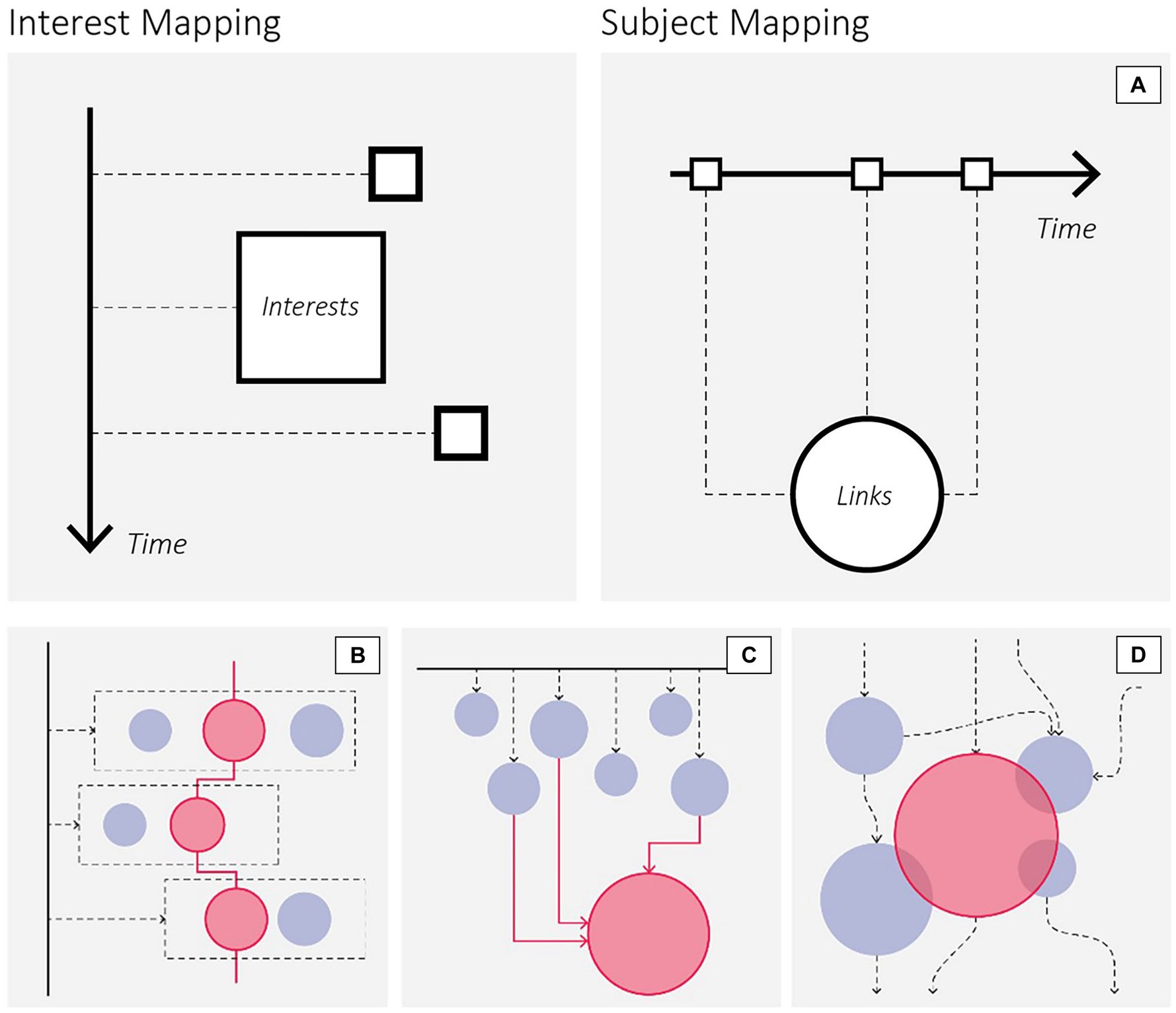
Figure 6. (A) Diagrammatic comparison of the timeline exercises, (B–D) utilisation of timeline exercises for the creative development of links and associations.
5.2. ePortfolio types and formats
The initial activities from Study 1 (group discussions and individual tasks) were designed to highlight the differences between traditional design portfolios and ePortfolios. The students were asked to identify: (1) the potential audiences for their ePortfolios, and (2) the interdisciplinary themes of interest within design and architecture that involved curricular and extracurricular activities that could prompt reflections across subjects and beyond university studies. With these aspects in mind, they participated in an online word cloud quiz in which popular results were sized based on the number of repeated mentions. This preliminary exercise was meant to overcome the bias of having previous exposure to traditional design portfolios and journals and to circumvent any limitations derived from previous studies or the constraints of a specific format or software package.
The initial ePortfolio prototypes highlighted the conceptual differences between project-based digital portfolios and the proposed design ePortfolios. The timeline and mapping exercise introduced the expectations of the ePortfolio goals and the tangible differences from a traditional design portfolio, in terms of pattern finding early in the process. However, moving from an exercise-based format into the development of the design ePortfolio itself presented further reflective potential with regard to structure and layout. While a traditional portfolio usually shows individual projects based on skill-set or conceptual ideas, the ePortfolio is not necessarily restricted in this way. The results from the thematic exploration became a clear impetus for the structure of the design ePortfolio, and students were encouraged to use their interests, highlighted in the earlier timeline and mapping exercises, as a method of structuring their design ePortfolios.
Student B’s ePortfolio was the one that most closely represented the anticipated outcomes of the original research proposals: her ePortfolio was structured on four themes: (1) environment, (2) urban fabric, (3) building, and (4) our senses. A critical aspect of the reflective nature of Student B’s ePortfolio was that, apart from the documentation of her projects (including her thoughts, comments, and reflections), she incorporated several additional sections, hierarchically structured as accordion-style dropdown menus, to densely pack information and interests within her ePortfolio, while not obstructing the overall flow of the webpage. Student B included references to precedents, texts, extra information and her commentary on each to provide other students with additional readings and resources (Figure 7).
Student C’s refined ePortfolio was focused on the inquiry process, and it was based on three initial provocations he had identified in his timeline. These were placed on his homepage under a short autobiography, and each was linked to a “provocation” page that featured a discussion area to share thoughts and provoke discussions. He also included a blog-like section at the bottom to facilitate viewers in writing comments for him to publish and respond to. Each provocation page comprised a brief comment and images of projects relevant to the theme (Figure 8).
A significant design aspect of Student C’s ePortfolio was how he illustrated and documented his design projects. Rather than each having a specific page, his aim was for the projects to be subordinate to the primary discussion of the provocations. The result was slide-in lightbox panels for each of his projects so that a viewer is never completely removed from the provocation. His ePortfolio confirmed the necessity of flexibility in the design platform to allow architecture students to communicate their identities creatively.
Student D’s refinement was the attempt that most closely translated the timeline exercise into an ePortfolio. Her opening pages function as an essay to introduce viewers to ePortfolio, her approaches to design, and key influences in her design journey (Figure 9A). Despite her earlier pages being in a simple text and image format, Student D translated the sprawling timeline diagram into an ePortfolio mind map that fully utilised the online platform’s links and took advantage of its interactive nature. Each bubble could be clicked to bring up a lightbox explaining the context and its relationship with other bubbles. Additional links are used to further discussions on theory, precedent projects, or her own documented projects. Each resource is then connected interactively (Figure 9B). Her inclination towards writing as a form of reflection served as a useful guide throughout the prototyping phase. The combination of the timelines developed in Section 3.1 and her writing assets gave her the structure and clarity needed to articulate her range of interests. Her experience highlights the importance of reflective writing for her to express and experiment with her interests. Furthermore, her experience reinforces the versatility of the timeline task as a reflective exercise and a point of reference for revisiting and refining ideas.
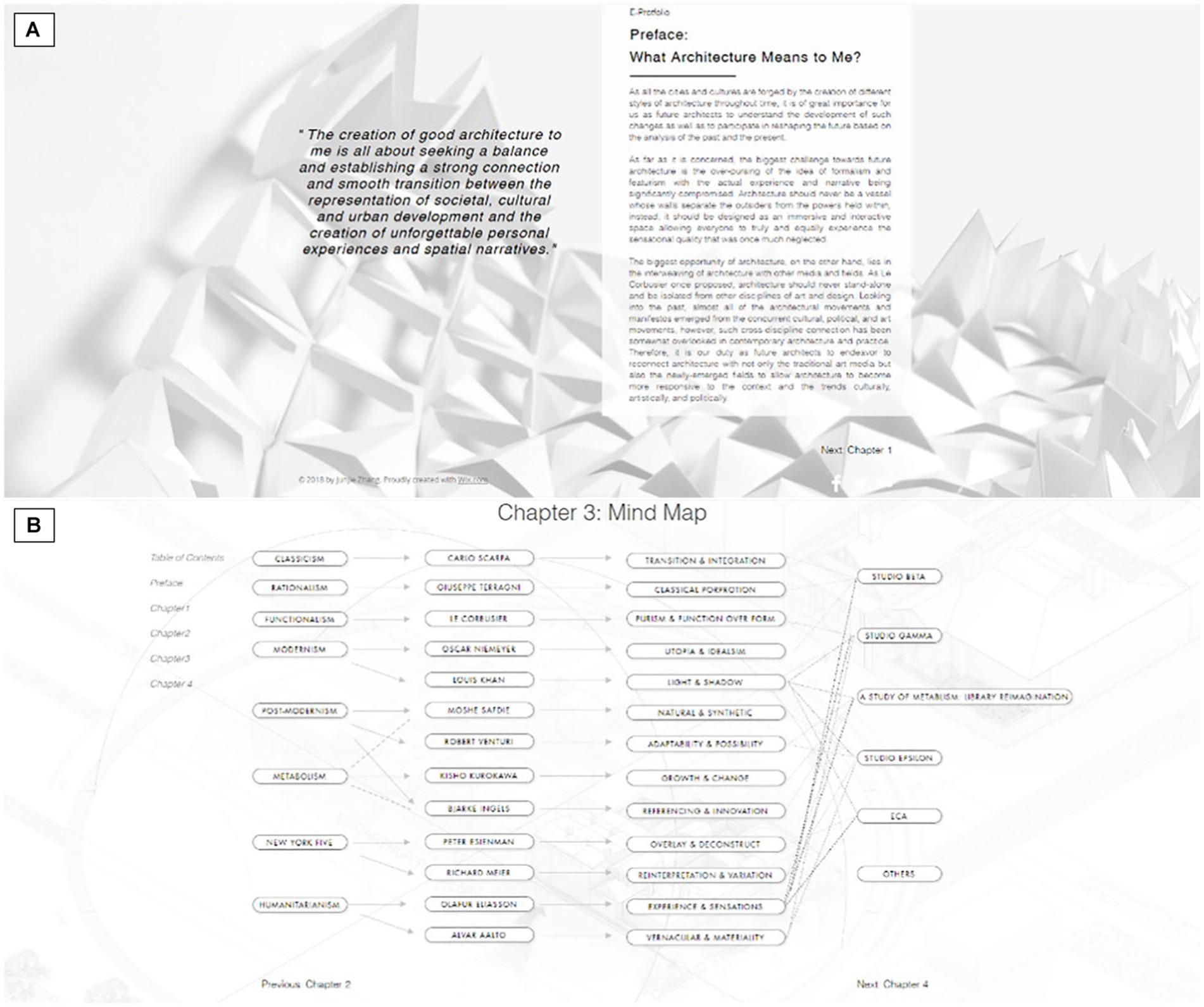
Figure 9. Snippets from Student D’s ePortfolio: (A) opening page; (B) mind map page (reproduced by permission).
Similarly, Student B and Student C found the writing process a key exercise in reflecting on their interests, as established through diagramming. Though they did not utilise this content directly as a reflective exercise, its development assisted them in consolidating these thoughts, how they structured their writing, and then how they went about the subsequent development of their ePortfolio prototypes.
Another student, Student G, initially took a more binary approach when developing her ePortfolio. Her continued interest in examining the duality of form was expressed using sliders that placed her projects between her definitions of polarising themes (Figure 10). This user interface supported her reflections on her work by clarifying her themes of interest. By expanding the criterion, she used to place her work within this framework, she developed a more refined understanding of her current work and the micro-intersections of themes she had explored.
The ePortfolio exercise also presented a unique opportunity for student participant Student H, who utilised the prototype development process to obtain a tangible and live representation of her interest in technology. Her ePortfolio prototype serves as a live log of exploration and a consciously self-referential evolving artefact. The secondary purpose assigned to her ePortfolio included the introduction of a resource page to resonate and assist like-minded creators by listing the tools she used and the anecdotes she learned through her experimentations (Figure 11).
The study exercises and outcomes highlighted that, in most cases, her motivations for adopting design approaches and thinking were correlated with her interests that predated her degree and those she developed during the degree or as a response to cultural influences.
Similarly, the participants with an explicit interest in architecture theory, who learnt specific architectural styles and movements, and the evolution of architectural technologies from their lecturers, promoted a later exploration of these ideas in design studios. The interests that have influenced their design thinking have also directly impacted how their ePortfolios were expressed. As evidenced by the development of the timeline diagram and outcomes, their ePortfolios remain a personal and graphical exercise, allowing students to distinguish themselves and their design identity. This diversity was pivotal to understanding: (1) the scope of the ePortfolio project, (2) its potential as a reflective and communicative tool, and (3) the role of visual communication in the development and showcase of the students’ identities.
The method and structure by which the students approached and refined their ePortfolio prototypes led to the development of student identity templates that graphically represented possible reflective approaches throughout the degree course. The purpose was to communicate design approaches and to format decisions more quickly for future students. Each approach reflected one or more of the outcomes produced during the study. The five developed student identity templates are shown in Figures 12–16, along with their example counterparts. These identities were then used to prepare tutor and student guidelines for the implementation of our design ePortfolio in the Capstone Architecture Design Studio of the BDes (available in Appendix B).
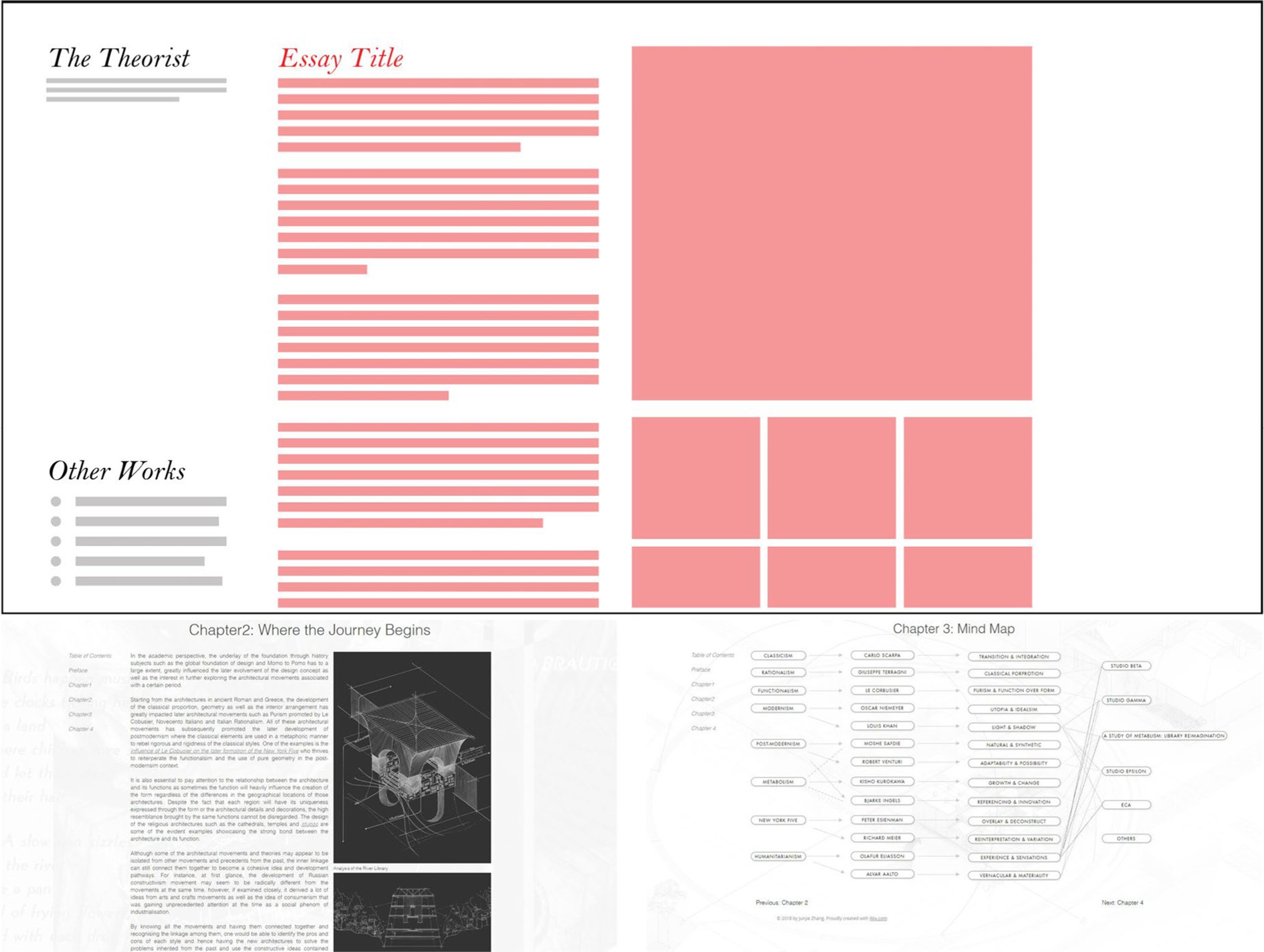
Figure 12. “The Theorist” identity derived from Student D’s ePortfolio (ePortfolio images reproduced by permission).
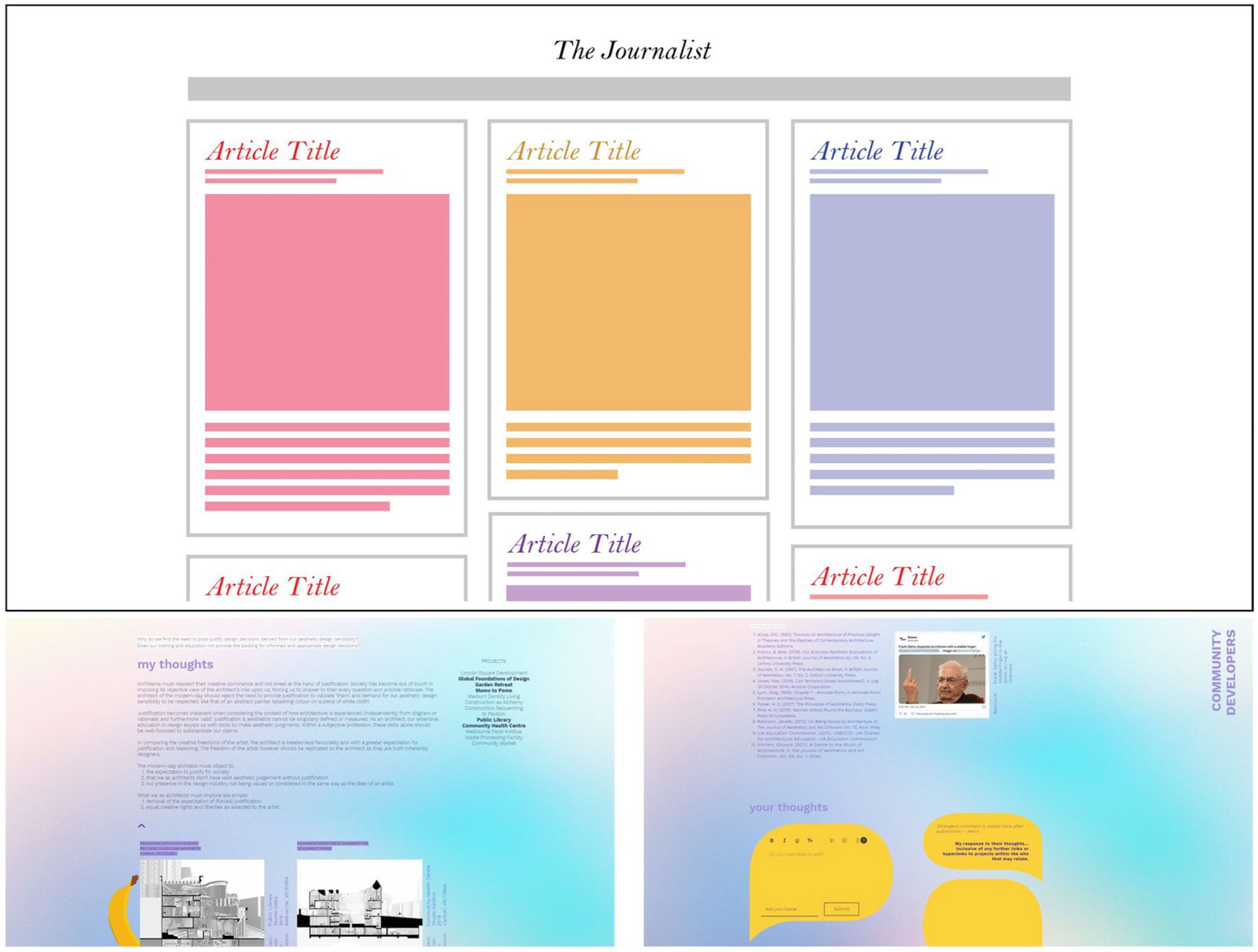
Figure 13. “The Journalist” identity derived from Student C’s ePortfolio (ePortfolio images reproduced by permission).

Figure 14. “The Engineer” identity derived from Student H’s ePortfolio (ePortfolio images reproduced by permission).
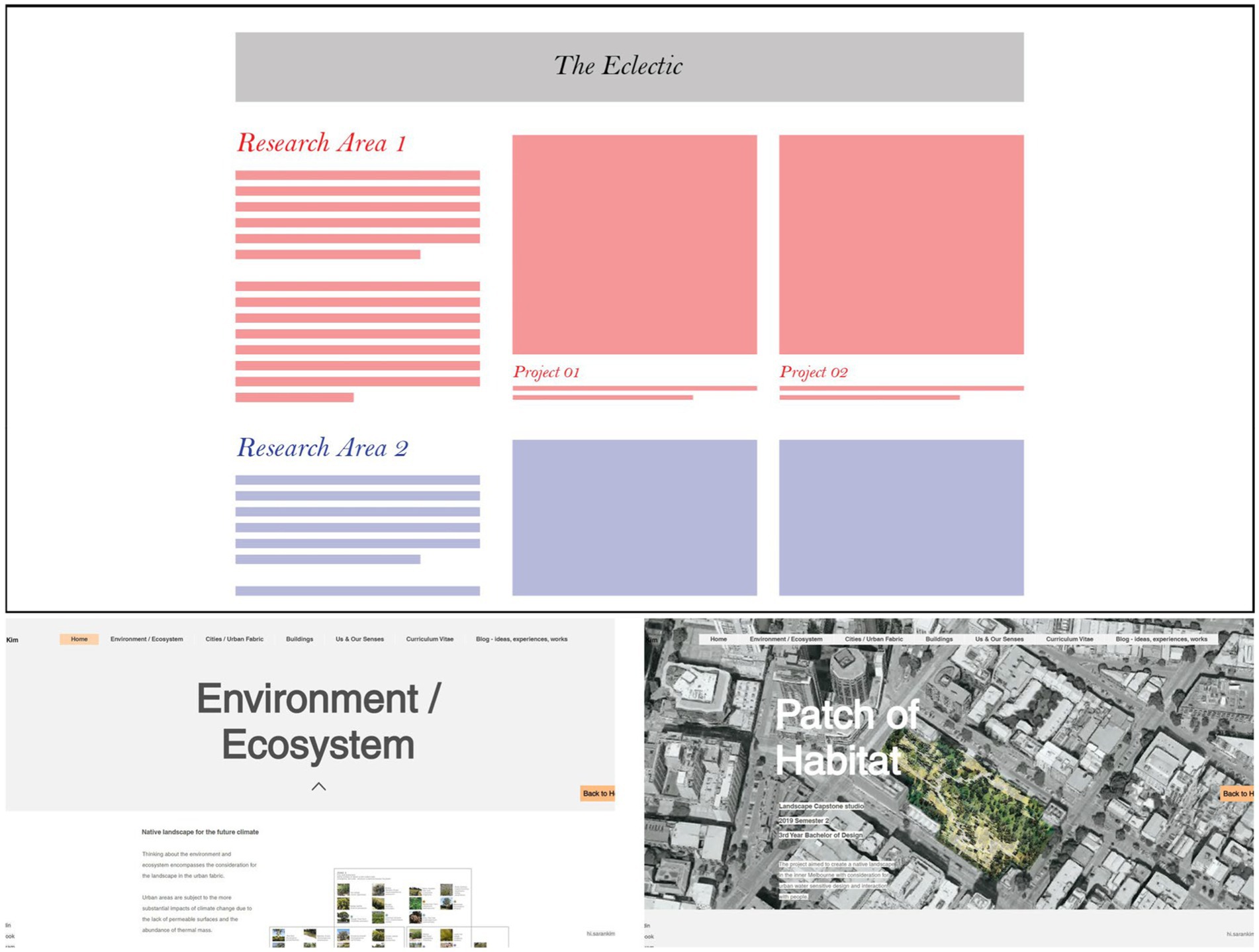
Figure 15. “The Eclectic” identity derived from Student B’s ePortfolio (ePortfolio images reproduced by permission).
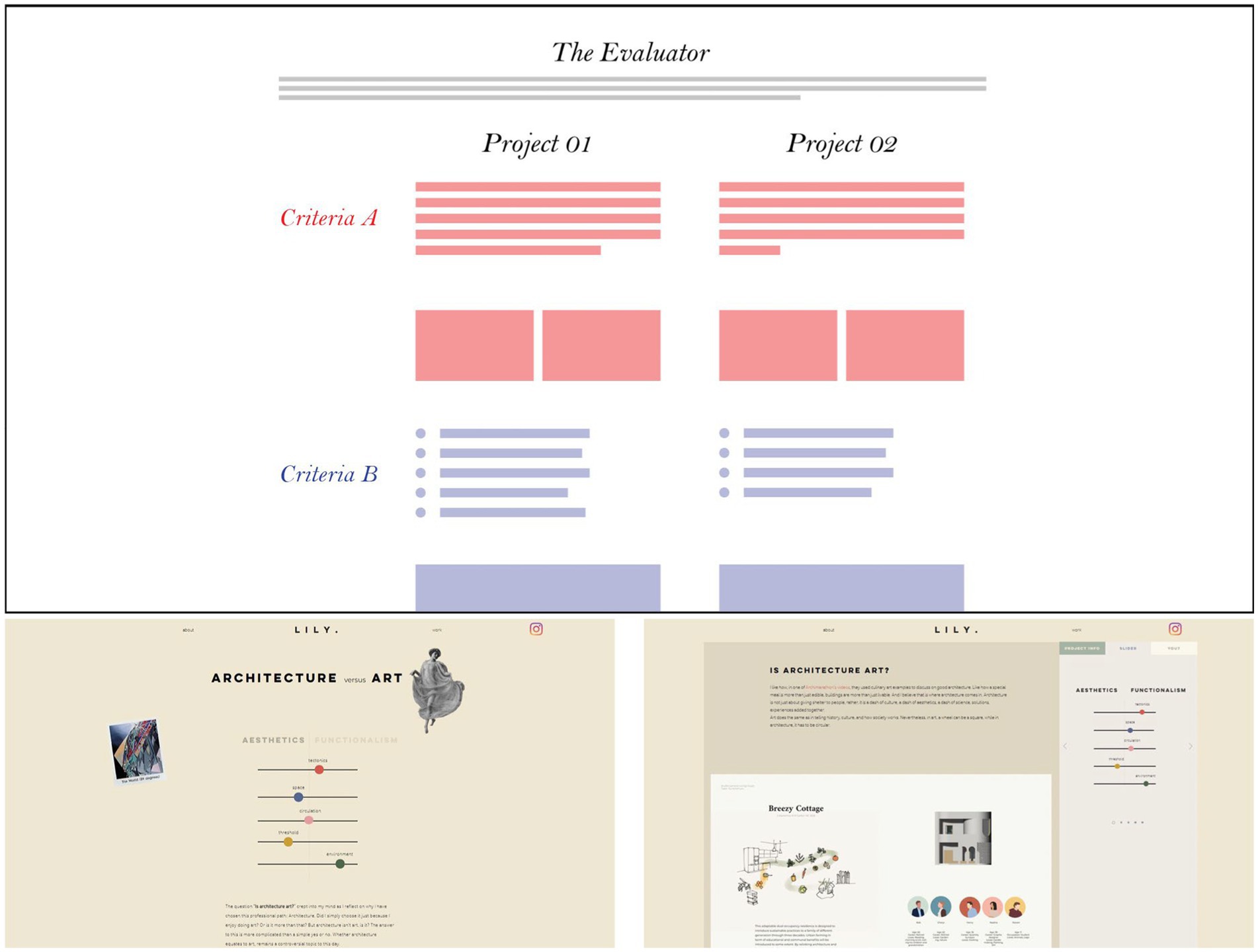
Figure 16. “The Evaluator” identity derived from Student G’s ePortfolio (ePortfolio images reproduced by permission).
The students’ approach to the design and construction of their ePortfolio demonstrated that this activity could foster a sense of pride in how they creatively shaped both the medium—their website design—and the message—the website content. The latter was conveyed following their critical thinking, passions, and skills, which was evident through their ePortfolio and was later confirmed through the final survey.
The design ePortfolios produced in this phase also demonstrated that the ePortfolio task could be student-centred and student-driven. Students were actively engaged in exploration and inquiry, with us assisting and coaching in the learning process and guiding them to develop critical thinking skills. The six students reviewed their past works, including personal achievements, activities, and assignments, through the new lens of their narrative and goals, taking ownership of their learning.
Along with these templates, descriptors were assigned to each identity, approximating the style through which each student approached their ePortfolio design. These descriptors of each approach are broad enough to provide a starting point for future students to project their ideas onto the provided identities or adapt them to their own experiences. These sample identities correspond to different approaches to the ePortfolio exercise, which we evaluated in Table 3 against the characteristics of a design ePortfolio, as initially described in Table 1.
A critical aspect of the ePortfolio focus on students’ identity is the growing concern about plagiarism in students’ works, especially for admission to master’s level courses. Because of their very nature, ePortfolios could allow the candidates to be assessed based on their proposed identity and, simultaneously, those students with a poorly developed authorial identity that may be at risk of unintentional plagiarism to be supported.
6. ePortfolio implementation in capstone
The generation of the ePortfolio prototypes prepared during Study 2 directed the final segment of the research towards strategies that could be used to implement more conventional pedagogy for the student’s learning construction process. The initial three levels of implementation within the architecture degree course involved the development of methods and strategies to incorporate ePortfolio at the course, subject, and task levels.
The course-level strategies were deemed the most appropriate choice to design the overall integration of ePortfolios. The subject and task level strategies were the best options for students to visualise connections within and between subjects and related subject streams (history & theory, design, environment, and technology) as building blocks of the final ePortfolio. The ePortfolio implementation within the Capstone Architecture Design Studio of the BDes was the one that best satisfied the opportunity for students to reflect on their work over the three-year undergraduate degree course while developing an ePortfolio to be used for further applications for professional work or postgraduate studies.
The implementation pedagogical strategy was based on a scaffolding process of prompt questions that had briefly been discussed with tutors during the semester, in which connections between new and old information were incentivised. As one of the main concerns was how to address students with low engagement levels and academic attainment, this task was deemed potentially positive to empower students to become active learners and take on ownership of their learning. However, the feedback time during tutorial classes would be limited compared to the long sessions provided in the focus groups, which formed a fundamental part of the success of the study outcomes. For this reason, the exercises and reflections were redesigned to guide students in building independence and confidence to complete the tasks in a relatively autonomous manner.
6.1. Tasks leading to the ePortfolio development
The Capstone-level implementation strategy involved scaffolding tasks and the progressive delivery of the exercises throughout the 12-week teaching semester. The activities were broken up into 4 three-week blocks and aligned with the design coursework of the Capstone Architecture Design Studio, as shown in Figure 17. This structure was based on the model developed during the research project. It involved 6 weeks of reflective exercises, 3 weeks of structural development, and 3 weeks of refinement of the ePortfolio outcome. The reflective exercises included the interest and subject mapping, and a formalised reflective writing task designed to build content for the ePortfolios and provided an explicit set of deliverables needed for assessment.
The structure and delivery of the tasks and outcomes had to be conveyed clearly, given that the opportunities for guidance from tutors would be less than in the study. Peer-to-peer discussions and reflections through the exercises and the immediacy in task results were encouraged.
For example, the reflective writing on interests and relationships in work could directly inform the concept design phase of their Capstone design project. Given the outcomes of the focus groups and the strong evidence that students tend to engage in learning when they: (1) exercise agency over their own learning, (2) contribute to the communities in which they learn, and (3) improve the learning programme for themselves and their peers (Hattie, 2009). The writing exercise was aimed at assisting lower-achieving students in understanding the positive implications of successful reflection and output for the ePortfolio exercises while, at the same time, not inhibiting the work of high-achieving students.
6.2. Teaching material and delivery format
The ePortfolio was delivered to students via four methods: (1) a subject-level overview lecture delivered by the coordinator, (2) pre-recorded tutorials, (3) an ePortfolio guidebook, and (4) in-class exercises (See Appendices A, B).
The pre-recorded tutorials, released every 3 weeks, were critical in guiding students and encouraging them to work progressively throughout the semester. The key contents of the pre-recorded tutorials were: (1) clarification of the learning objectives and outcomes of the exercises, and (2) presentation of selected examples, especially identities and prototypes.
The guidebook and in-class sessions were developed as more discrete instructions and prompts for the exercises and templates the students could utilise for the reflective tasks. Miro templates were designed to provide a visual way for students to brainstorm and reflect while encouraging the graphical exploration and communication of the ePortfolio exercise.
6.3. Assessment criteria
We referred to the Intended Learning Outcomes (ILOs) of the Architecture Major of the BDes rather than the ILOs of the subject to develop assessment criteria because the design ePortfolio task covers the entire degree and concerns students’ activities and artefacts produced throughout their undergraduate studies.
We aligned our assessment criteria to the following course ILOs:
•Position design propositions within a physical, historical, social and cultural context.
•Application of a range of communication skills and techniques, including verbal, written, analogue, and digital visual strategies, to convey a variety of conceptual, experimental and sensory design intentions.
•Present, substantiate, and advocate for design proposals in a public setting, and accept critique in a constructive manner.
•Acquire knowledge and skills required to pursue further study in the Architecture discipline, as well as to enter the Architecture profession both locally and globally.
We defined one assessment criterion for each of the 4 three-week tasks described in Figure 17 to mark the design ePortfolio development, and we used a separate criterion to mark the final design ePortfolio submission.
The Capstone rubric gives full marks to:
•Interest and Subject Mapping diagrams that establish connections between significant milestones and interests that have informed the students’ approach to their academic development and are graphically cohesive and demonstrate a strong understanding of the reflective nature of the task. Effective timeline diagrams illustrate strong connections between personal interests, projects, and academic learning, and are developed into thematic interests.
•Reflective Writing that suggests a high level of thematic reflection and research, as well as an understanding of opportunities for further development and incorporation of knowledge into existing and future projects.
•Identity Development exercises that showcase the student’s identity, interests, and professional development, including a discussion of strengths and weaknesses and a plan of action.
•ePortfolio drafts that critically reflect on the subject content and the degree as a whole and make thematic links between research and the artefacts developed. The ePortfolio drafts present a clear narrative and communication style, which is further evidence of identity under development.
6.4. Students’ reflections
After developing the ePortfolio prototypes, the students completed a short survey about their perceptions of this task and how it could be implemented in the coursework. We also sent a follow-up survey to each of the participating students 6 months after the completion of the prototype to hear their thoughts on the meaningfulness of the implementation of the ePortfolio in the Capstone Architecture Design Studio.
The responses were positive as the students expressly referred to how the ePortfolio encouraged cross-disciplinary relationships across the course material and helped consolidate ideas, enhancing their work. A few students also mentioned that, although they had understood the importance of being reflective, there was rarely any motivation to try and structure or formalise thoughts meaningfully. The ePortfolio thus inspired them to appreciate why they were interested in specific aspects of architecture.
Regarding the Capstone implementation, the participating students agreed that the ePortfolio could be a valuable tool to enhance their design projects. Being encouraged to consider themes and personal areas of interest could only help them to benefit from the conceptual development of the studio design project. However, one of the participants suggested that the reflective exercises could be implemented much earlier in the degree course to introduce students to this level of reflective thinking before entering the Capstone.
Many students mentioned introducing ePortfolio development as early as the first year to form a more cohesive understanding of the coursework. These comments, consistent with earlier concerns regarding the timing of the ePortfolio implementation, formed the basis of the integration within the architectural coursework. In 2022, an ePortfolio activity was introduced into the first-year Architecture Design Studio to prompt students to reflect on (1) the complexity of and contradictions in the design process, and (2) how the choice of building materials and a basic structural system impacted their final design thinking.
7. Conclusion
As the practice of ePortfolio continues to develop in Australian universities, this research has substantiated that an ePortfolio is a valuable tool for architecture students, a result which was achieved through focus study groups, surveys and the implementation of an ePortfolio as a formal assessment in the “Architecture Major” of the BDes at The University of Melbourne.
The type of ePortfolio that could best support the learning, reflection, experimentation, and progress of students in core subjects within the undergraduate architecture degree course proved to be a multidisciplinary one, and not only focused on the construction and technology stream of the architecture degree, as initially envisaged.
The early adoption of an ePortfolio in the Capstone Architecture Design Studio demonstrated that the ePortfolio had to be introduced in the first year of studies to disseminate the concept of metacognitive reflection and active learning as a step-by-step journey in which low-stake assignments were assessed. The experimental adoption of the ePortfolio project has recently been evaluated in two first-year core subjects, and it was launched towards the end of 2022. It is worth noting that the successful adoption of ePortfolio in the first year will likely determine a more straightforward implementation within the Capstone Architecture Design Studio and assist in developing a student-centric learning strategy.
This framework can easily be implemented and expanded by other universities because the exercises work as blocks, and further activities can be developed to accommodate the specific requirements of schools. Further research and the analysis of the influence of ePortfolios on design outcomes for architecture students may be conducted to enhance self-reflection and improve how architecture is taught and learned.
The choice of media contributed to the discussion on the students’ approaches to the representation and structure of their ePortfolio prototypes. The students’ decision to customise their ePortfolio through a free cloud-based website builder was seen as an opportunity for creativity. However, the need to support and simplify the communication and representation of the students’ journeys led to the development of templates that will be further simplified and constitute an internal repository for future students.
Data availability statement
The raw data supporting the conclusions of this article will be made available on demand by the authors. Requests to access the datasets should be directed to SC, s.colabella@unimelb.edu.au.
Ethics statement
The studies involving human participants were reviewed and approved. Approval to conduct focus groups and interviews with the ABP students was obtained from The University of Melbourne Human Ethics Committee (Application ID: 2057662; project title: “Building’ your e-portfolio: iterative assessment through shaping a personalised profile across architectural core subjects”). All participants provided their written informed consent to participate in these studies. Participants also permitted to reproduce their ePortfolio drafts in this article.
Author contributions
This project was designed and coordinated by SC and AP. MM and CW contributed to the project in the role of Research Assistants. SC and AP chaired the focus groups with the student participants and analysed the ePortfolio outcomes with MM and CW. MM and CW conducted the interviews with the student participants. The results were analysed and discussed as a group to readapt the subsequent phases of the research. SC and AP designed and coordinated the final ePortfolio implementation in the Capstone Architecture Design Studio of the BDes in collaboration with MM and CW, who developed teaching and learning resources, with guidelines, and video tutorials. SC designed and coordinated the ePortfolio implementation in the first-year Architecture Design Studio of the BDes. SC and AP, who are joint first authors of this paper, conceived the initial structure of the article. MM contributed to the definition of the final article structure and the design of all flowcharts and tables. MM and CW drafted the Results section and prepared all the images and the Supplementary material. SC and AP jointly wrote the Abstract, and the Introduction, ePortfolio background, Methodology, ePortfolio Implementation and Conclusions sections. All the authors contributed to the discussion and approved the final manuscript.
Funding
The project was supported by funding from the Learning and Teaching Initiatives (LTI) Grants 2020 of The University of Melbourne for projects focusing on assessment reform.
Acknowledgments
The authors respectfully acknowledge the Wurundjeri and Ngunnawal peoples, who are the traditional custodians of the lands on which this research took place. The authors are grateful for the assistance and support provided by colleagues and associates with advice and the current best practices to assess portfolios in higher education: Prof Clare Newton, who has extensive experience with teaching grants, helped conceive and design the research and provided supervisory support throughout the project; Prof Greg Missingham, who is an expert in the assessment of teaching and learning activities, helped define the evaluation rubrics for the implementation in the Capstone Architecture Design Studio; Djordje Stojanovic, coordinator of the Capstone Architecture Design Studio of the BDes, who supported the testing and implementation of our ePortfolio through conversations and discussions on the design of assessment tasks and assessment rubrics. The authors are also grateful to all the students who participated in the focus groups and interviews with curiosity and enthusiasm. All the students whose work was reproduced in this paper have agreed to the reproduction, and given consent to being identified, acknowledged, and thanked for their contribution to the project: Student A: Veronica Lee. Student B: Saran Kim. Student C: Thomas Martiniello. Student D: Junjie Zhang. Student E: Ellen Zaharis. Student F: Josh Budgen. Student G: Thin Myat Noe (Lily). Student H: Isabel Solin. Approval to conduct focus groups and interviews with the ABP students was obtained from The University of Melbourne Human Ethics Committee (Application ID: 2057662; project title: “Building’ your e-portfolio: Iterative assessment through shaping a personalised profile across architectural core subjects”).
Conflict of interest
The authors declare that the research was conducted in the absence of any commercial or financial relationships that could be construed as a potential conflict of interest.
Publisher’s note
All claims expressed in this article are solely those of the authors and do not necessarily represent those of their affiliated organizations, or those of the publisher, the editors and the reviewers. Any product that may be evaluated in this article, or claim that may be made by its manufacturer, is not guaranteed or endorsed by the publisher.
Supplementary material
The Supplementary material for this article can be found online at: https://www.frontiersin.org/articles/10.3389/feduc.2023.1169363/full#supplementary-material
Footnotes
1. ^The JISC ePortfolio implementation toolkit can be found at: https://epip.pbworks.com/w/page/28670505/The%20e-portfolio%20implementation%20toolkit (accessed February 19, 2023).
2. ^The ePortfolios developed at the Pennsylvania State University can be found at: https://sites.psu.edu/pedagogicalpractices/e-portfolios (accessed February 19, 2023).
3. ^The ePortfolios developed at the Pennsylvania State University can be found at: https://sites.psu.edu/pedagogicalpractices/e-portfolios/#usage (accessed February 19, 2023).
4. ^From the ePortfolio instructions developed by the Pennsylvania State University: https://mediacommons.psu.edu/storytelling/ (accessed February 19, 2023).
5. ^The gallery of ePortfolios produced at Griffith University can be found at: https://www.griffith.edu.au/learning-futures/pebblepad/showcase (accessed February 19, 2023).
6. ^The results of the ePortfolio Project at University of Auburn can be seen at: http://auburn.edu/academic/provost/university-writing/eportfolio-project (accessed February 19, 2023).
References
Batson, T., Coleman, K. S., Chen, H. L., Watson, C. E., Rhodes, T. L., and Harver, A., eds. (2017). Field guide to Eportfolio. Washington, DC: Association of American Colleges and Universities.
Barker, K. C. (2006). EPortfolio for skilled immigrants and employers: LIfIA project phase one final report. Available at: https://research.qut.edu.au/eportfolio/wp-content/uploads/sites/186/2019/01/AeP_Report_ebook_Aug-2008.pdf
Barrett, H. (2010). Balancing the two faces of ePortfolios. Educação, Formação e Tecnologias 3, 06–14.
Bass, R., and Eynon, B. (eds.). (2009). “The difference that inquiry makes: a collaborative case study on technology and learning, from the visible knowledge project”. Academic Commons. Available at: http://academiccommons.org/.
Belcher, R., Jones, A., Smith, L.-J., Vincent, T., Naidu, S. B., Montgomery, J., et al. (2014). Qualitative study of the impact of an authentic electronic portfolio in undergraduate medical education. BMC Med. Educ. 14:1. doi: 10.1186/s12909-014-0265-2
Biggs, J., and Tang, C.. (2011). Teaching for quality learning at university. New York: Open University Press.
Bleasel, J., Burgess, A., Weeks, R., and Haq, I. (2016). Feedback using an ePortfolio for medicine long cases: quality not quantity. BMC Med. Educ. 16:1. doi: 10.1186/s12909-016-0801-3
Cheung, H. L., Fisher, D., Pickard, V., and Chan, Y. F.. (2009). “Scaffolding student learning: integrating EPortfolios into the university experience”. Refereed conference paper presented at 34th improving university teaching international conference, Burnaby, Canada.
Creswell, J., and Plano Clark, V. (2007). Designing and conducting mixed methods research. Thousand Oaks, CA: Sage.
Hallam, G., and Creagh, T. (2010). ePortfolio use by university students in Australia: a review of the Australian ePortfolio project. High. Educ. Res. Dev. 29, 179–193. doi: 10.1080/07294360903510582
Hattie, J. A. C. (2009). Visible learning. A synthesis of over 800 meta-analyses relating to achievement. New York: Routledge.
Joyes, G., and Smallwood, A.. (2011). E-portfolio large-scale implementations – the ePI study. JISC final report, University of Nottingham. Available at: https://epip.pbworks.com/w/file/fetch/51444408/finalreportepIMarch12012.pdf
Kirschner, P. A., and Hendrick, C. (2020). How learning happens: seminal works in educational psychology and what they mean in practice. Oxfordshire: Routledge.
Reynolds, C., and Patton, J. (2014). Leveraging the ePortfolio for Integrative Learning: A Faculty Guide to Classroom Practices for Transforming Learning. Sterling, Virginia: Stylus Publishing.
Roco, M., and Barberà, E. (2020). Integrating E-portfolio strategy in the architectural design studio. Des. J. 23, 575–595. doi: 10.1080/14606925.2020.1769974
Schön, D. A. (1991). The reflective practitioner: how professionals think in action. Oxfordshire: Routledge.
Veneruso, S. S., Black, E., Chaden, C., Habron, G., Muller, K., Stephens, B. R., et al. (2017). “Promoting student cognitive development: integrative learning, reflection and metacognition” in Batson, Trent, Coleman, Kathryn S., Chen, Helen L., Watson, C. Edward, Rhodes, Terrel L., and Harver, Andrew, eds. Field guide to eportfolio. Washington, DC: Association of American Colleges and Universities.
Keywords: reflective design ePortfolio, architecture design studio, pedagogy, design education, ePortfolio implementation, ePortfolio development, ePortfolio identities
Citation: Colabella S, Pugnale A, Mack M and Woo CMM (2023) Supporting the journey of architecture students towards graduation through a design ePortfolio. Front. Educ. 8:1169363. doi: 10.3389/feduc.2023.1169363
Edited by:
Leman Figen Gul, Istanbul Technical University, TürkiyeReviewed by:
Gunsu Merin Abbas, Eindhoven University of Technology, NetherlandsDerya Yorgancıoğlu, Özyeğin University, Türkiye
Copyright © 2023 Colabella, Pugnale, Mack and Woo. This is an open-access article distributed under the terms of the Creative Commons Attribution License (CC BY). The use, distribution or reproduction in other forums is permitted, provided the original author(s) and the copyright owner(s) are credited and that the original publication in this journal is cited, in accordance with accepted academic practice. No use, distribution or reproduction is permitted which does not comply with these terms.
*Correspondence: Sofia Colabella, cy5jb2xhYmVsbGFAdW5pbWVsYi5lZHUuYXU=
†These authors have contributed equally to this work
 Sofia Colabella
Sofia Colabella Alberto Pugnale
Alberto Pugnale Michael Mack
Michael Mack Catherine Mei Min Woo
Catherine Mei Min Woo